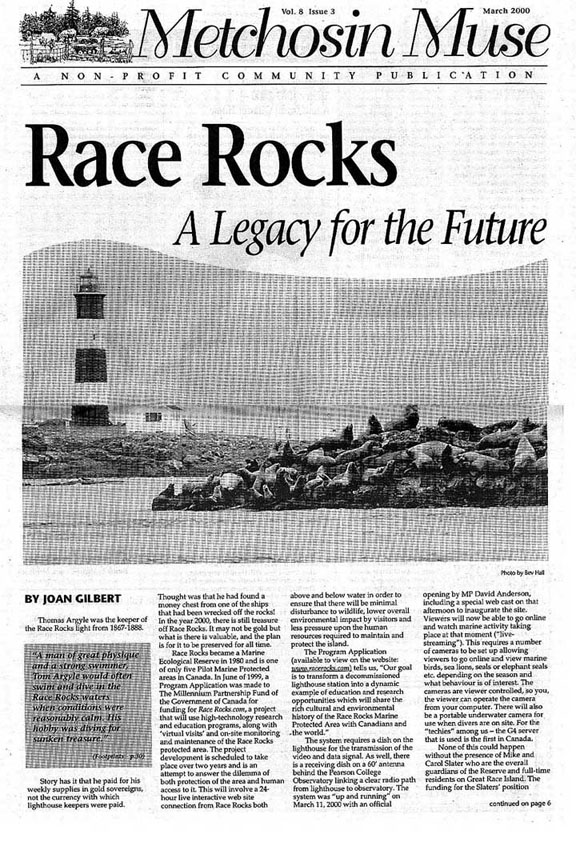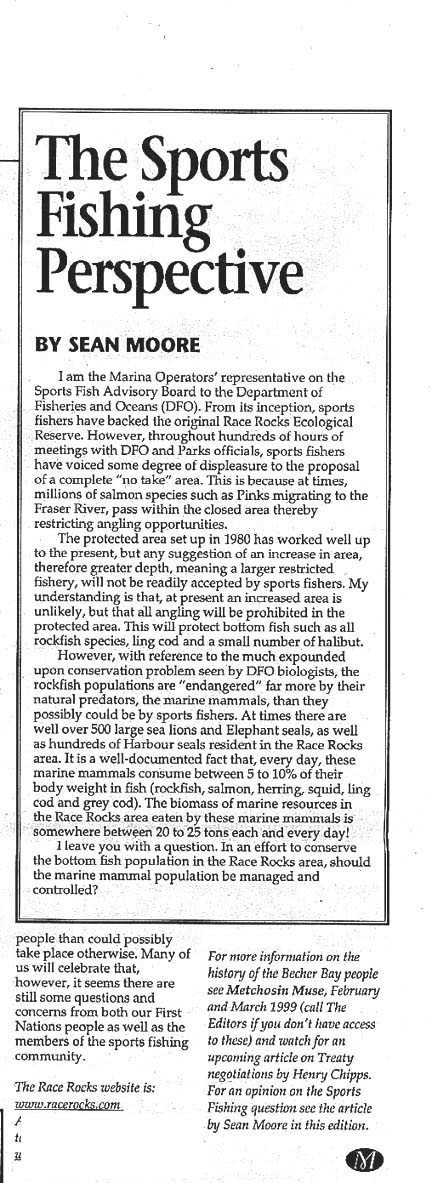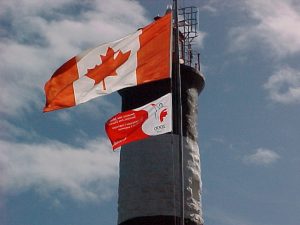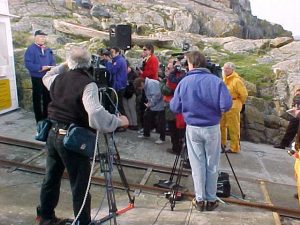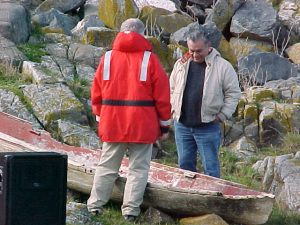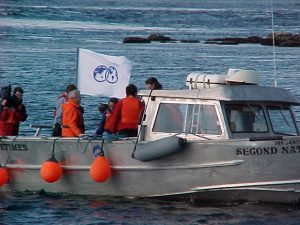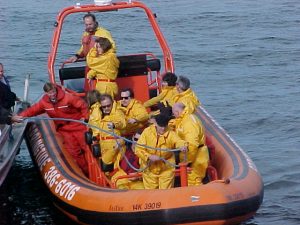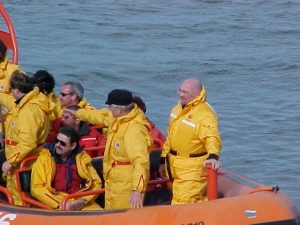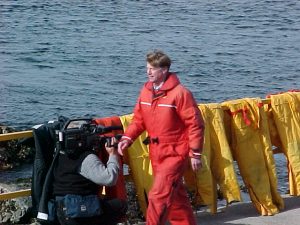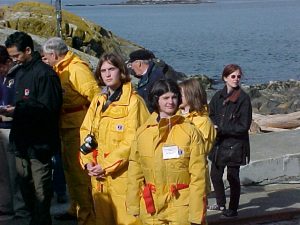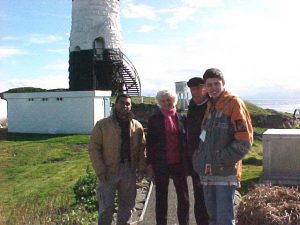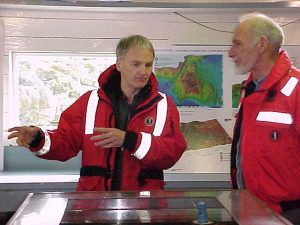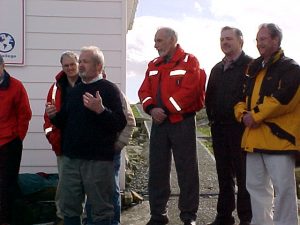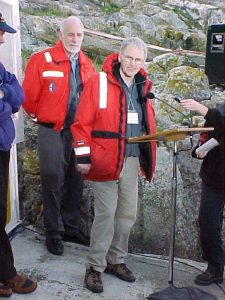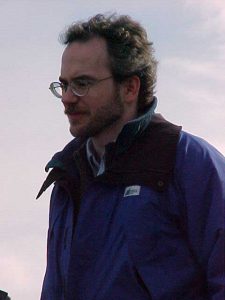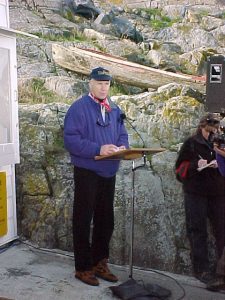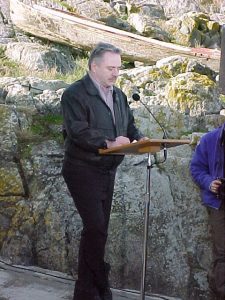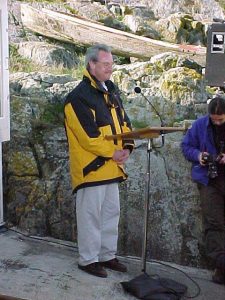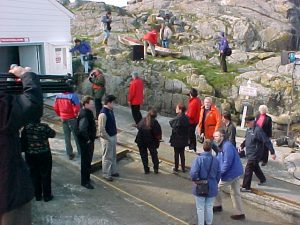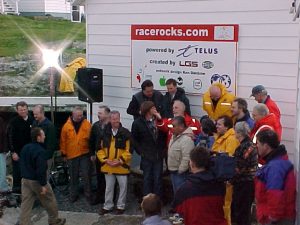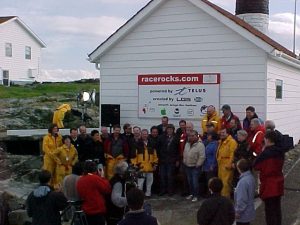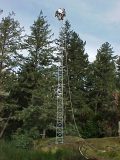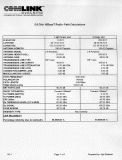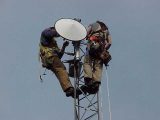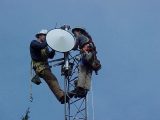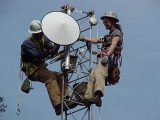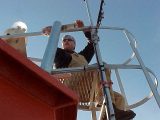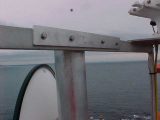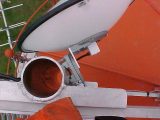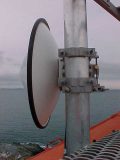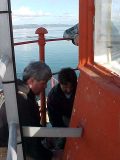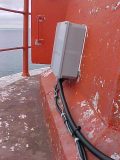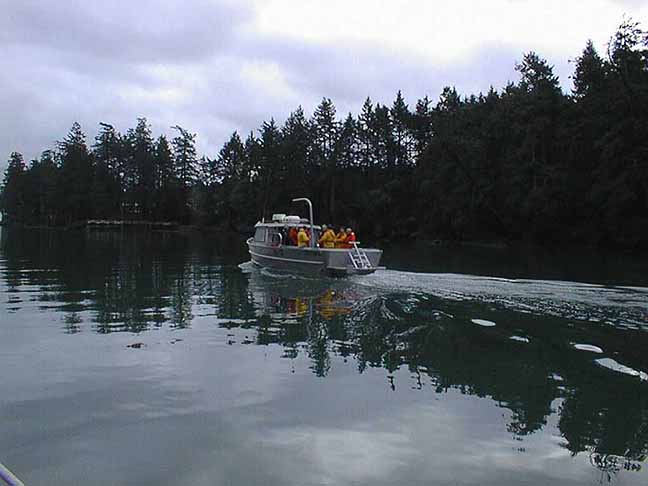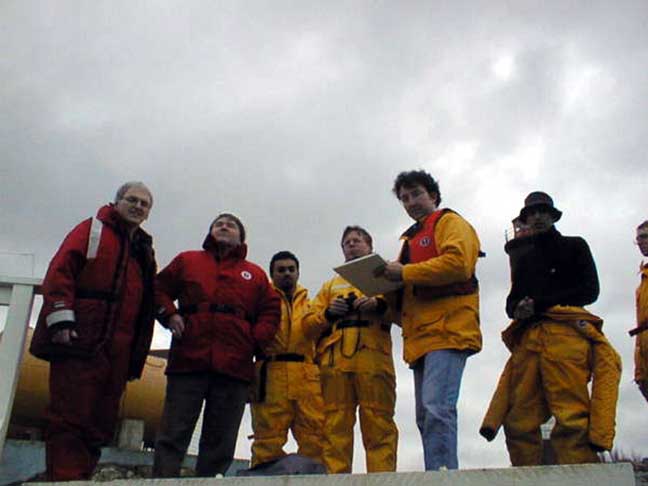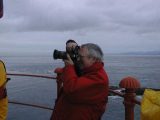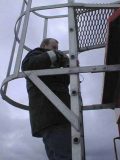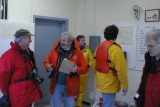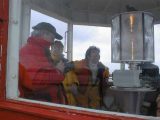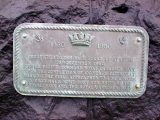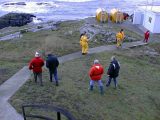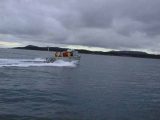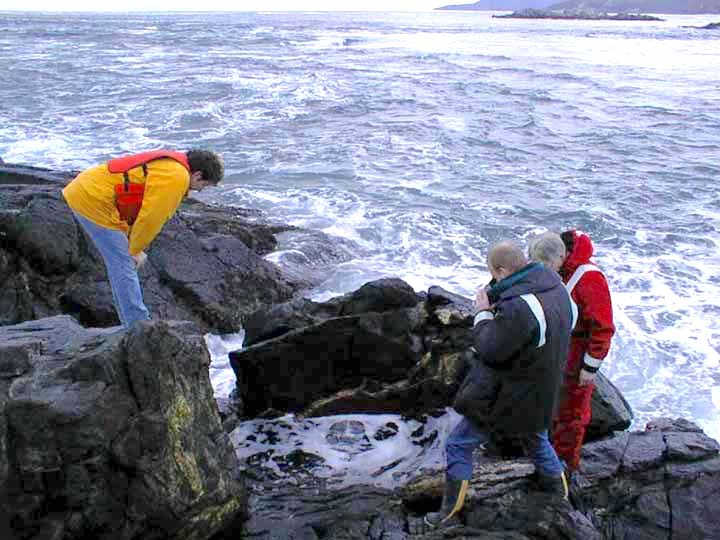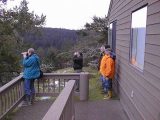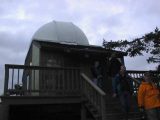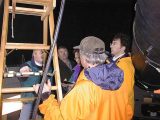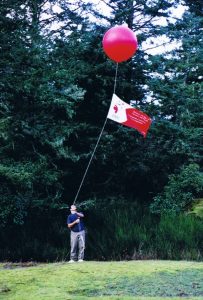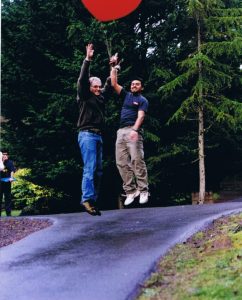Category Archives: Facility work
Race Rocks Ecological Reserve – Marine Protected Area (RR ER-MPA) Draft Management Plan
Race Rocks Ecological Reserve – Marine Protected Area
(RR ER-MPA) Draft Management Plan
- Map
- Executive Summary
- Acknowledgments
- Introduction
- Objectives, Background and Action?
- Key Management Issues?
- Appendix 1: Ecosystem Overview?
Race Rocks Ecological Reserve – Marine Protected Area will be managed to protect the rich intertidal communities and to encourage educational and research benefits while minimizing impacts.
The relationship with Lester B. Pearson College will be formalized to assist in the education, research and management of the ecological reserve – marine protected area.
The addition of Great Race Rock will be pursued to protect the integrity of the area and its values. If Great Race Rocks is acquired the lighthouse lands will be designated as a Protected Area under the Environment and Land Use Act. The former lighthouse buildings will be operated in conjunction with Lester B. Pearson College (under permit) and other partners as an education and research centre to complement the intent of the Race Rocks Ecological Reserve – Marine Protected Area.
To provide increased protection to resident groundfish populations, BC Parks will, in consultation with DFO and stakeholders and through direction provided by the emerging joint federal-provincial Marine Protected Areas Strategy, investigate the implications and feasibility of implementing full recreational harvesting closures in Race Rocks either under the federal Fisheries Act or designating the area as a Marine Protected Area under the Oceans Act.
The plan was coordinated by Kris Kennett, BC Parks Planner. Garry Fletcher of Lester B. Pearson College developed the initial draft plan, and provided expert knowledge and information. Assistance and expertise was provided by various BC Parks staff including: David Chater, District Manager; Chris Kissinger, Resource Officer; Don McLaren, Area Supervisor; Mona Holley, Acting Wildlife Ecologist; Doug Biffard, Marine Ecologist; Ken Morrison, Conservation Planner and Jim Morris, District Planner and Fisheries and Oceans staff: Doug Andrie, Integrated Coastal Zone Management Coordinator; and, Marc Pakenham, Community Advisor.
The objective of the ecological reserve – marine protected area strategy in British Columbia is the conservation of representative and special natural ecosystems, plants and animal species, features and phenomena. Ecological reserves and marine protected areas contribute to the maintenance of biological diversity and the protection of genetic materials. They also offer opportunities for scientific research and educational activities. In many ecological reserve – marine protected areas, non-consumptive low-intensity uses such as nature appreciation, wildlife viewing, bird watching and photography are allowed and Race Rocks Ecological Reserve – marine protected area – Marine Protected Area features many of these activities.
Race Rocks Ecological Reserve – Marine Protected Area was created to protect a unique small rocky island system, intertidal areas and high current subtidal area in the eastern entrance of the Strait of Juan de Fuca. It is located off the southern tip of Vancouver Island, approximately 17 km. southwest of Victoria. It covers an area of 220 ha and includes nine islets, but does not include Great Race Rock. It was established in 1980 as a result of a proposal by the students and faculty of Lester B. Pearson College.
Purpose of the Race Rocks Ecological Reserve — Marine Protected Area Feasibility Study Plan
This plan defines management goals and objectives for Race Rocks Ecological Reserve – Marine Protected Area. It provides the strategies and guidance necessary to protect and manage the ecological reserve – marine protected area, particularly concerning the protection of natural values, recreation use, research and education uses. The management plan will be the working tool that will require periodic updating. Specific recommendations are documented for a multi-year management program.
Vision
Race Rocks Ecological Reserve — Marine Protected Area will continue to protect the high-energy marine system found in the eastern entrance of the Strait of Juan de Fuca. Research will assist in the management of the ecological reserve – marine protected area and contribute to the knowledge base of marine systems. The ecological reserve – marine protected area will provide opportunities to increase the awareness of students, visitors and the general public about marine systems and the ecological reserve – marine protected area program. Lester B. Pearson College and the surrounding community will play a large role in the education, research and management of this area. Non-consumptive low-intensity educational uses such as nature appreciation, wildlife viewing, bird watching and photography will continue.
OBJECTIVES
- To contribute to the protection of marine biodiversity, representative ecosystems and special natural features.
- To contribute to the conservation and protection of fishery resources and their habitats.
- To contribute to the protection of cultural heritage resources and encourage understanding and appreciation.
- To support recreation and tourism opportunities.
- To provide scientific research opportunities and support sharing of traditional knowledge.
- To enhance efforts for increased education and awareness.
- To develop partnerships for management and protection of the ecological reserve – marine protected including monitoring and reporting activities.
- To develop working relationships and educational programs with First Nations
To contribute to the protection of marine biodiversity, representative ecosystems and special natural features.
Background:
Establishing boundaries is a difficult task, given the problems associated with establishing ‘markers’ in a marine environment. The present boundaries were determined by the normal limits of SCUBA diving and based on the contours of the nautical charts of the time. This has created a situation where features are not captured and the boundary is not well-defined. In addition, metric charts are now the standard which makes the ‘fathom’ description more difficult to determine.
The ecological reserve is protected under the Ecological Reserve Act and the Ecological Reserve Regulations. In addition, the penalty provisions of the Park Act can now be used to assist in protecting the ecological reserve – marine protected area and its values. Organisms in the water column are not subject to provincial legislation, being under the jurisdiction of the federal government.
Fisheries and Oceans Canada can manage marine resources under the Fisheries Act and the new Oceans Act. The Oceans Act, enacted in January 1997, also gives DFO the authority to establish Marine Protected Areas (MPAs). Under this Act, MPAs can be established for a number of purposes, including conservation and protection of: commercial and non-commercial fisheries resourced; marine mammals and their habitats; endangered or threatened species and their habitats; unique habitats; and areas of high biodiversity or biological productivity. Race Rocks Ecological Reserve and its values, particularly the protection of resident groundfish populations, would benefit from the implementation of full harvesting closures under the Fisheries Act or designating it as a Marine Protected Area under the Oceans Act.
Great Race Rock is surrounded by the ecological reserve – marine protected area but is not part of it. It is the largest island in the group and supports a lighthouse station, which is federally administered. Recently, the federal government has been automating lighthouses and returning surplus Crown provincial land to the provincial government for others uses. BC Parks has the opportunity to add Great Race Rock to the ecological reserve – marine protected area.
Action:
In conjunction with DFO, investigate opportunities to expand the boundary from the existing 36.5 m (20 fathom) contour to the 50 m contour.
Investigate opportunities to establish global position system coordinates for identification of the ecological reserve – marine protected area.
Identify ecological reserve – marine protected area boundaries on marine charts and related marine guides and publications.
BC Parks will, through consultations with other agencies, such as DFO and stakeholders and through direction provided by the emerging joint federal-provincial Marine Protected Areas Strategy, investigate the implications and feasibility of implementing full recreational and commercial harvesting closures in Race Rocks either under the federal Fisheries Act or designating the area as a Marine Protected Area under the Oceans Act.
Develop a protocol agreement with DFO to ensure consistent management of the water column and the land base.
Pursue the addition of Great Race Rock to the ecological reserve – marine protected area.
- Cooperate with Parks Canada and their national marine conservation area feasibility study.
To contribute to the conservation and protection of fishery resources and their habitats.
Background:
Race Rocks Ecological Reserve protects a provincially, if not nationally, significant high-current subtidal and intertidal ecosystem. The reserve has ecologically significant and unique assemblages of benthic and pelagic invertebrates. It protects several rare species, including the spiral white snail Opalia, and many rare hydroid species (such as Rhysia fletcheri), that represent unique Canadian or North American occurrences and provides haul outs and feeding areas for elephant seals, sea lions, breeding areas for harbour seals and nesting habitat and migrating resting areas for seabirds.
In 1991, DFO closed Race Rocks Ecological Reserve to commercial fin and shellfish harvesting for all species. Race Rocks is also closed to recreational harvest of shellfish, ling cod and rock fish but remains open for salmon and halibut. Fishing for salmon still occurs inside the ecological reserve – marine protected area boundaries, whereas halibut is largely found in the deeper, adjacent waters.
Oil spills next to the ecological reserve – marine protected area could potentially be devastating to the sensitive intertidal communities, marine mammal and bird populations. The ecological reserve – marine protected area probably has a relatively short time for self cleansing given its location in a high current zone with high energy exposure from both easterly and westerly winds in the Strait of Juan de Fuca. However, options for protection of this valuable ecosystem in the event of an oil spill should be investigated.
The lighthouse station on Great Race Rock poses two threats to the marine environment. First, sewage from the residences is being discharged directly into the water column. Although the extreme tidal flushing lessens the impact, this situation is not appropriate in an highly valued marine environment. Second, electricicty is provided by diesel generators, and diesel spills pose a hazard to the environment. Alternative technologies for sewage treatment and power generation, such as composting toilets and solar energy, should be investigated. Composting toilet has already been installed in assistant’s residence.
Visitors to the ecological reserve – marine protected area can severely impact the delicate underwater communities by anchoring, or disturb nesting sea birds or resting sea lions and seals by landing or passing too close to these small islets. Boats driven in the reserve at high speeds endanger the marine mammals.
Action:
Develop a marine management plan to ensure protection of intertidal and rare species and to ensure that elephant seals, harbour seals, California and Steller’s sea lions, and seabirds are not disturbed on their haulout and nesting sites.
In conjunction with Lester B. Pearson College and commercial tour operators, develop a code of conduct for visiting the ecological reserve – marine protected area to ensure protection of natural values and to maintain a high quality educational experience (including speed restrictions).
Discourage landings on islands through the provision of information and permit requirement.
Discourage anchoring in the ecological reserve – marine protected area through the provision of information.
In conjunction with Marine Protected Areas Strategy initiative, work with DFO in consulting all stakeholders to explore the implementation of full harvesting closures under either the Fisheries Act or the Oceans Act in order to assist in the protection of resident groundfish populations.
Ensure the recognition and clear information of the boundaries of the ecological reserve – marine protected area, speed limits and its protective status are clearly described in the BC Sports Fishing Regulations, on marine charts and guides.
In conjunction with the Oil Spill Recovery Information System (OSRIS), develop and register a strategy for protection of the ecological reserve – marine protected area in the event of an oil spill.
Work with the federal government to clean up and improve the site, including the removal of the present sewage disposal facilities and diesel tanks. Pursue opportunities for compensation. Investigate opportunities to utilize alternative technologies. Monitor technology that supports more intensive use remotely with less impact on the ecological values. Institute a monitoring program to determine marine and terrestrial site degradation or enhancement within the ecological reserve – marine protected area.
To contribute to the protection of cultural heritage resources and encourage understanding and appreciation.
Background:
One of the main objectives of the ecological reserve – marine protected area program is to provide opportunities for scientific research. Race Rocks Ecological Reserve has been very successful at fulfilling this objective through the interests and actions of Lester B. Pearson College. The college undertakes and assists in most of the research conducted at Race Rocks. The students and faculty provide local knowledge, orientation services and willing assistants to other researchers. They also monitor permanent transects and conduct their own research as part of their course requirements.
BC Parks encourages research that contributes to the long-term protection and understanding of ecosystems. Research priorities reflect BC Parks’ mandate, with emphasis on conservation objectives, acute and chronic management problems, and rare and endangered species. To achieve this, research proposals are subjected to a systematic review process. The collected data are required to be made available and shared with the scientific community. As required by the Ecological Reserve Regulations, researchers must require a permit through BC Parks to legitimize their activities.
In the past, Lester B. Pearson College developed a good working relationship with the Coast Guard and the lighthouse keepers. The College was able to use some of the buildings to assist in their research. With the automation of lighthouses, Lester B. Pearson College has taken the opportunity of formalizing the use of the surplus buildings for a two-year period ending in 1999 and presently (since March 1997) employed the former light keepers to stay at Race Rocks. The College proposes to continue to utilize the facilities as an education and research centre.
Action:
With assistance from Lester B. Pearson College and other researchers, develop a long-term research and monitoring plan to minimize impact to ecological reserve – marine protected area values and maximize research opportunities and benefits.
Ensure all researchers have permits.
Operate buildings on Great Race Rock as a research and education centre, as funding permits. Work with community groups such as Lester B. Pearson College and other partners for the ongoing operation and funding for such as facility through a long term permit.
Develop a comprehensive permit with Lester B. Pearson College which define roles and responsibilities for education, research and management.
To provide scientific research opportunities and support sharing of traditional knowledge.
Background:
Education is another objective of ecological reserve – marine protected areas. Since the late 1970s, Lester B. Pearson College has been using the ecological reserve – marine protected area as an outdoor classroom and educational facility for students from both the college and local schools. In addition, groups like Friends of Ecological reserve, naturalists, and commercial operators visit the ecological reserve – marine protected area as part of their education programs.
Films and live televised programs such as the “Underwater Safari” series assist in developing an appreciation of the biodiversity with little impact on the ecological reserve – marine protected area. Approval for filming takes into account the purpose of the filming and the type of footage in relation to the purpose of the ecological reserve – marine protected area and the current inventory of ‘stock’ footage available.
The Internet is another means of education. In 1995, Lester B. Pearson College established files connected to their website with information on Race Rocks Ecological Reserve – marine protected area – Marine Protected Area, an ecological reserve – marine protected area publications list and intertidal photographic transects. Since that time the site has expanded to include more records of research, profiles of organisms, tidepools, as well as history. This has raised awareness globally and has resulted in students from other parts of the world undertaking comparative studies.
Race Rocks has a colorful marine history, with the ships that sunk as a result of the rocks and the building of the lighthouse. Little is known about First Nations historical interests and use of the ecological reserve – marine protected area. The college has established an archive on the internet of relevant historical information and images.
Action:
Undertake proactive measures to provide educational information to the public and visitors. Ensure accurate information in fishery regulations, provide information at points of entry (such as marinas); ensure the ecological reserve – marine protected area is mapped on marine charts and navigation guides.
Work with Lester B. Pearson College and other community groups to provide: low impact educational opportunities for schools and the community; offsite educational opportunities; and information on the Internet.
Continue to permit filming for only educational and research purposes. Develop stock footage to respond to standard filming requests.
Monitor the level of educational use and take management actions where necessary and in consultation with Lester B. Pearson College, commercial tour operators and others.
Develop, in consultation with Lester B. Pearson College and First Nations, educational information on ecosystems and the cultural and marine history of Race Rocks Ecological Reserve – Marine Protected Area.
Update existing Race Rocks Ecological Reserve – Marine Protected Area brochure to reflect management direction established in this plan.
5. Objective:
To permit educational opportunities that have minimal impact to the ecological reserve – marine protected area and increase public awareness, understanding and appreciation for Race Rocks Ecological Reserve – Marine Protected Area and its values.
Background:
Ecological reserve – marine protected areas are established to support research and educational activities. Visitation to the waters surrounding Race Rocks Ecological Reserve – marine protected area – Marine Protected Area has been increasing, particularly those engaged in wild life viewing and diving. Uncontrolled, uninformed and excessive use could result in: behavioral changes or injury to marine mammals and seabirds; poaching of sealife; or physical injury or mortality from handling or improper dive techniques. Given the proximity of the ecological reserve – marine protected area to Victoria and the interest in these types of activities, commercial and recreation use will continue to grow.
Given the roles of ecological reserves – marine protected areas, uses that occur at Race Rocks should contribute to education or research objectives without negatively impacting the natural values. This may include commercial tours.
Action:
Subject to an impact assessment, only issue permits for commercial activities that are educational or research oriented.
Work with the volunteer warden, Lester B. Pearson College, to provide annual orientation session for commercial operators and tour guides. Continue to provide public information to increase awareness of the ecological reserve – marine protected area, the potential of ecological impact of various activities, and the need for caution in the ecological reserve – marine protected area. This would include: brochure; accurate information in BC Sports Fishing Regulations; information at points of entry; mapping on marine charts and navigational guides; internet/web site.
Work with commercial operators and researchers to develop a code of conduct within the ecological reserve – marine protected area to ensure protection of the natural values and to maintain a high quality educational experience. Develop a monitoring system with Lester B. Pearson College, site guardian, researchers and commercial tour operators to ensure appropriate behavior of diving and wild life viewing companies and other visitors.
Develop an outreach program and stewards program to assist with the management, and to develop respect for the ecological reserve – marine protected area and its values.
Discourage anchoring in the ecological reserve – marine protected area.
As per the Ecological reserve – marine protected area Regulations ensure that commercial operators in the ecological reserve – marine protected area have permits for their activities.
To enhance efforts for increased education and awareness.
Background:
Commercial and sports fishing, nature tours, marine traffic, and explosives testing occur in the waters surrounding the ecological reserve – marine protected area. Presently, a part of Great Race Rock is administered by the federal government and partly by Lester B. Pearson College. Although most of the land base will be returned to the Province, the tower, which has been automated, will continue to be administered by the Canadian Coast Guard.
A number of federal and provincial initiatives for planning in the marine environment are either proposed or underway. These include the Pacific Marine Heritage Legacy, Marine Protected Areas Strategy and strategic planning for marine areas that is consistent with the Vancouver Island Land Use Plan.
Action:
Establish communications with CFB Esquimalt to determine the impact of nearby explosives testing on, the ecological reserve – marine protected area, and develop mitigative measures if necessary.
Work with DFO to lessen the impact of fishing, whale watching, seal and sea lion observing and bird watching.
Before Great Race Rock property reverts to the Province, work with federal government to clean up and improve site, including the removal of sewage disposal facilities and diesel tanks. Pursue opportunities for compensation. Investigate opportunities to utilize alternative technologies.
Develop protocol with Coast Guard for their continuing operation of the light tower, including helicopter landings, marine access, repairs.
Work with federal and provincial agencies in marine planning initiatives.
To develop partnerships for management and protection of the ecological reserve – marine protected including monitoring and reporting activities.
Background:
Under the volunteer program, BC Parks has an ecological reserve – marine protected area warden program to provide on-site monitoring and reporting on ecological reserve – marine protected areas. Since the establishment of Race Rocks Ecological Reserve – Marine Protected Area, the Biology and Environmental Systems faculty and students at Lester B. Pearson College have taken on the role of warden. They were greatly assisted by the former lighthouse keepers stationed at Race Rocks who monitored activities in the ecological reserve – marine protected area and reported violations such as commercial fishing, shooting of sea lions and oiled birds on islands. Since the automation of the lighthouse, the college has an interim agreement with the Coast Guard to use the facilities for the next two years and they have generated private funding to keep the former lighthouse keeper in place as a guardian until March 1, 1998. The role of the site guardian is to support Pearson College’s activities on the island and alsoupport the College’s ecological reserve – marine protected area warden duties (e.g. provide information and report violations).
BC Parks is now developing a broader conservation stewardship initiative under the volunteer program. This program will encourage community involvement in the stewardship of parks and ecological reserve – marine protected areas. Given the interest in Race Rocks Ecological Reserve – marine protected area – Marine Protected Area and its proximity to an urban centre, there are opportunities to implement the program here. The integrity of the ecological reserve – marine protected area will be assisted by involving tour operators and other interests in the stewardship of Race Rocks.
Action:
- Work with Lester B. Pearson College as host warden to assist in the management of the ecological reserve – marine protected area. Develop a protocol agreement to define relationship and outline roles and responsibilities for education, research and management, including operation of research facility on Great Race Rock.
- In consultation with the volunteer warden, Lester B. Pearson College, develop opportunities for operators, naturalists and others to contribute to the stewardship of the ecological reserve – marine protected area.
- Develop procedures to report violations in order to assist with enforcement.
- Work with Lester B. Pearson College to provide a presence or guardian to assist in information distribution, education, monitoring and reporting of violations.
- Work with DFO and the Coast Guard to enforce site-specific fisheries regulations and objectives.
To develop working relationships and educational programs with First Nations
Background:
First Nation interests and traditional uses of Race Rocks are not documented. A good working relationship between BC Parks and the First Nations people is needed to ensure BC Parks is fulfilling its fiduciary obligations and to develop a mutual understanding of the values of the ecological reserve – marine protected area and its ongoing protection.
Action:
Consult with representatives from the Beecher Bay, T’souke, Songhees and Esquimalt First Nations to understand the traditional uses of Race Rocks ecological reserve – marine protected area.
Ensure regular communication on ecological reserve – marine protected area management issues.
- Investigate opportunities to undertake a traditional use and education study.
- Establish joint management initiatives.
Relationship with Other Land Use Planning
Ecological Reserve – Marine Protected Area Boundaries
Cooperation with the Federal Government
Cooperation with Lester B. Pearson College
Management of Research Activities and Facilities
Management of Education Activities
Management of Recreation and Commercial Activities
Conservation and Representation
Surrounding Land Use
Community Stewardship
Relationship with First Nations
KEY MANAGEMENT ISSUES
Management planning processes provide a mechanism for public review and support for management strategies. In this respect, an ecological reserve – marine protected area management plan must be considered in terms of its relationship with other land use strategies.
In June 1994, the provincial government announced the Vancouver Island Land Use Plan. This plan recommended that strategic planning occur for marine areas. Marine planning units have now been identified and planning framework statements summarizing values and capabilities have been prepared for the next level of planning. Race Rocks and surrounding areas are included in this process.
The marine environment of the Pacific coast is not well represented in either federal or provincial protected areas systems. The federal and provincial governments are committed to establishing a system of marine protected areas and are developing a strategy to this end. A separate but related initiative is the Pacific Marine Heritage Legacy (PMHL), where the federal and provincial governments are working to form a network of coastal and marine protected areas along the southern Pacific coast. Race Rocks Ecological Reserve – Marine Protected Area is situated adjacent to a study area for a national marine conservation feasibility study which will be initiated in 1998-99 as part of the PMHL Program.
Key Management Issues
The ecological reserve – marine protected area includes an area of ocean, nine small islands and reefs bounded by the 36.6 metres contour, which is an outdated notation that does not follow natural features. Because of the presence of the Canadian Coast Guard light station, Great Race Rock has not been included in the ecological reserve – marine protected area. With the decommissioning of these stations, Great Race Rock is available to be added to the ecological reserve – marine protected area to enhance its integrity.
Jurisdictional responsibilities for the management of the marine environment and marine resources are shared between the federal and provincial governments. For example DFP is responsible for organisms in the water column. The Coast Guard is presently reponsible for the management of Great Race Race Rock. The province has jurisdication over the other islands and the land under the water column. The provincial government is working with federal government agencies of DFO, Parks Canada and Environment Canada to develop and implement a marine protected areas strategy, and with Parks Canada to implement the PMHL program. The Canadian Forces Base (CFB) in Esquimalt tests explosives in the area, which may impact the ecological reserve – marine protected area’s values. Cooperation with the Coast Guard, DFO, Parks Canada and CFB Esquimalt is essential to ensure the best protection for the ecological reserve – marine protected area.
Lester B. Pearson College was instrumental in the establishment of the ecological reserve – marine protected area. The faculty and students of the Biology and Environmental Systems program at Pearson College are long-time volunteer ecological reserve – marine protected area wardens. They are actively involved in research and education activities and provide an important monitoring function. Lester B. Pearson College has a temporary agreement with the Coast Guard to operate a research station at the lighthouse on Great Race Rock. Clarification of roles and responsibilities of both Lester B. Pearson College and BC Parks are needed to ensure successful management of the ecological reserve – marine protected area.
Race Rocks Ecological Reserve – Marine Protected Area provides outstanding marine research opportunities. Lester B. Pearson College has been the principal research agency and has developed a good database for the ecological reserve – marine protected area and its values. The College has pursued options to use the decommissioned lighthouse buildings as a research and education facility and guardian base.
Given the proximity of an urban centre, Race Rocks Ecological Reserve – Marine Protected Area provides excellent educational opportunities. Lester B. Pearson College uses Race Rocks for their marine ecology program for college and local school students and naturalists. Tourism operators from Victoria offer educational nature tours as well. These activities must be managed to ensure protection of the values of the ecological reserve – marine protected area.
Commercial and non-commercial recreation activities such as wild life viewing, diving, boating and nature appreciation occur in the ecological reserve – marine protected area, both in the water and on land. These activities require cooperative management with the federal government, tour operators and recreational users to ensure that the values of the ecological reserve – marine protected area are maintained.
Background Summary
The Race Rocks Ecological Reserve – Marine Protected Area Background Report (Appendix 1) provides information on the ecological reserve – marine protected area to provide the basic information and assist in understanding the rationale behind the management plan.
Plan Implementation
This section compiles all the actions listed through this plan into three categories.
The implementation plan is divided into three components: ongoing management, priority one actions, and priority two actions.
Ongoing Management
Discourage anchoring and landings on islands in the ecological reserve – marine protected area through the provision of information.
Undertake proactive measures to increase awareness of the ecological reserve – marine protected area, the potential of ecological impact of various activities and the need for caution in the ecological reserve – marine protected area. This would include providing information such as the ecological reserve – marine protected area brochure at points of entry and ensuring accurate information and mapping in BC Sports Fishing Regulations, marine charts and navigational guide.
Only issue permits for activities that are educational or research oriented. Ensure all researchers and commercial operators have permits.
Work with Lester B. Pearson College and other community groups to provide: low impact educational opportunities for schools and the community; offsite educational opportunities; annual orientation session for commercial operators and tour guides; and information on the Internet.
Continue to permit filming for only educational and research purposes. Develop stock footage to respond to standard filming requests.
In consultation with Lester B. Pearson College as the ecological reserve – marine protected area warden, monitor the level of educational use and take management actions where necessary. This may include a site guardian to assist in information distribution, education, monitoring and reporting of violations to BC Parks.
Establish communications with CFB Esquimalt to limit testing near, and impact on, the ecological reserve – marine protected area.
- Work with DFO and the Coast Guard to protect the values of the ecological reserve – marine protected area and to lessen the impact of fishing, whale watching and seal and sea lion observing.
Ensure regular communication with First Nations on ecological reserve – marine protected area management issues.
Priority One Actions
Develop a protocol agreement with DFO to ensure consistent management of the water column and the land base.
Pursue the addition of Great Race Rock to the ecological reserve – marine protected area. ( done in 2002)
Support the application of Park Act Regulations and penalties to ecological reserve – marine protected areas.
Cooperate with federal and intergovernmental initiatives such as Pacific Marine Heritage Legacy, Marine Protected Areas Strategy, Parks Canada’s national marine conservation area feasibility study, and other marine planning initiatives.
Work with operators and researchers to develop code of conduct within the ecological reserve – marine protected area to ensure protection of the natural values and to maintain a high quality educational experience.
Work with the federal government to clean up and improve site, including the sewage disposal facilities and diesel tanks. Pursue opportunities for compensation. Investigate opportunities to utilize alternative technologies.
With assistance from Lester B. Pearson College and other researchers, develop a long-term research and monitoring plan to minimize impact to ecological reserve – marine protected area values and maximize research opportunities and benefits.
- Develop a protocol agreement with Lester B. Pearson College to define relationship and outline roles and responsibilities for education, research, and management issues, including operation of a research facility on Great Race Rocks. Develop a comprehensive research and park use permit with Lester B. Pearson College.
Operate buildings on Great Race Rock as research education centre, as funding permits. Work with community group such as Lester B. Pearson College for the ongoing operation and funding for such as facility through a long term permit.
Develop a monitoring system with Lester B. Pearson College, guardian, researchers and operators to ensure that appropriate behavior of diving and whale watching companies.
Develop protocol with Coast Guard for their continuing operation of the light tower, including helicopter landings, marine access, repairs.
Develop procedures to report violations in order to assist with enforcement.
Consult with representatives from the Beecher Bay and T’souke First Nations to determine their traditional use in the ecological reserve – marine protected area.
Develop a marine management plan to ensure protection of intertidal and rare species and to ensure that elephant seals, harbour seals, California and northern sea lions, and seabirds are not disturbed on their haulout and nesting sites.
In conjunction with DFO, investigate opportunities to expand the boundary from the existing 36.5 m (20 fathom) contour to the 50 m contour.
Investigate opportunities to establish global position system coordinates for identification of the ecological reserve – marine protected area.
In conjunction with the MPA Strategy initiative, pursue the feasibility of establishing Race Rocks as a marine protected area under the Oceans Act.
In conjunction with OSRIS, develop and register a strategy for protection of the ecological reserve – marine protected area in the event of an oil spill.
Develop, in consultation with Lester B. Pearson College and First Nations, educational information on ecosystems, history and culture of Race Rocks Ecological Reserve – Marine Protected Area.
Develop outreach program and stewards program to assist with the management, and develop respect for the ecological reserve – marine protected area and its values.
- In consultation with Lester B. Pearson College, develop opportunities for operators, naturalists and others to contribute to the stewardship of the ecological reserve – marine protected area.
Investigate opportunities to undertake a traditional use study.
Introduction
The objective of the ecological reserve – marine protected area program is to preserve representative and special natural ecosystems, plants and animal species, features and phenomena. Ecological reserve – marine protected areas contribute to the maintenance of biological diversity and the protection of genetic materials. Scientific and educational activities are the principal reasons for ecological reserve – marine protected areas. Most ecological reserve – marine protected areas are open to the public for uses that are non-consumptive, educational, low-intensity such as natural appreciation, wildlife viewing, bird watching and photography.
Race Rocks Ecological Reserve – Marine Protected Area was created to protect an unique small rocky island system, intertidal and high current subtidal areas in the eastern entrance of the Strait of Juan de Fuca. It has ecologically significant and unique assemblages of benthic and pelagic invertebrates. In addition, it is a haul out and feeding areas for seals and sea lions and a nesting and staging area for seabirds.
Ecological Reserve – Marine Protected Area Description
Location and Access
Race Rocks Ecological Reserve – marine protected area – Marine Protected Area is located 17 km south west of Victoria at 123∞ 31.85’W latitude and 48∞ 17.95’N longitude. It is 1.5 km off the extreme southern tip of Vancouver Island at the eastern end of Strait of Juan de Fuca. Given the marine environment, access is limited. A Canadian Coast Guard helicopter pad is located on Great Race Rocks (which is excluded from the ecological reserve – marine protected area). Only seaworthy vessels are able to approach the ecological reserve – marine protected area, given the extreme sea conditions and lack of sheltered moorage.
Size and Boundaries
The ecological reserve – marine protected area is 220 ha to a depth of 20 fathoms (36.6 metres). It is almost entirely subtidal, although nine islets comprise less than 1 ha. The present boundaries were determined by the normal limits of SCUBA diving and the contour lines of nautical charts.
History of Ecological Reserve Establishment
Race Rocks Ecological Reserve – marine protected area – Marine Protected Area was first proposed by Lester B. Pearson College in 1979. Concerned about the effect of increasing visitation and harvesting, the marine biology teacher, Garry Fletcher, and his students sought legal protection. Their goal was to ensure the preservation of marine mammals, sea birds and underwater organisms for future generations. They were assisted by Brent Cooke of the Royal British Columbia Museum, Dr. Paul Breen of the Pacific Biological Station in Nanaimo, Dr. Derek Ellis of the University of Victoria and a host of other advisors. Garry and his students undertook 80 dives to collect data. They compiled background information to support ecological reserve – marine protected area designation including: observation records; species checklists; bottom profiles; tidal currents; salinity levels; and temperature variations. They also offered to undertake the responsibility for stewardship of the area as volunteer wardens. Their role wou be to provide information to divers and advised them of appropriate behavior. They would also continue to accumulate information and serve as assistants to researchers.
With the data collected by Lester B. Pearson College, the Race Rocks area fit the criteria for ecological reserve designation and was proclaimed under Order In Council no. 692, March 27, 1980.
Natural Features
Physical Features
The ecological reserve – marine protected area is almost entirely subtidal, but includes nine islets, comprising less than 1 ha in total. Intertidal and subtidal zones have substrates primarily of continuous rock and a rugged topography which includes cliffs, chasms, benches and surge channels. The location at the southern tip of Vancouver Island, plus the rugged shallow sea bottom, result in strong currents, eddies and turbulence.
Geology
The geology of Race Rocks is volcanic in origin, with the islets being offshore basalts. Granite and quartz intrusive, probably of the undeformed kind, are evident. Sediment basins can be found in subtidal areas.
Oceanography
The important oceanographic features which have a bearing on biodiversity are tides, currents, wave action, water temperature and turbidity.
Tidal currents are a major oceanographic feature of Juan de Fuca Strait. The ebb and flood tides and residual current have a major influence on the water structure. In addition, Race Rocks is a transition zone between the inner waters and the open ocean. For ebb tide that funnels water from the low-salinity, nutrient-rich waters of coastal rivers such as the Fraser and countless tidal marshes along the Strait of Georgia and Puget Sound through the narrow part of the Strait of Juan de Fuca. The flood tides, that bring in water from the nutrient-rich upwellings of the open Pacific Ocean. As tidal flow surges past the rugged topography of Race Rocks results in ‘racing’ current, eddies and turbulence. Currents flow with velocities of two to seven knots and change direction according to tide, wave and wind direction. The wave action is more pronounced at Race Rocks due to the exposure to the outer portion of the Strait of Juan de Fuca. The variability in undersea topography results in waves being reflect, diffracted and refracted in irregular patterns, resulting eddies and complex tides.
The water temperature is generally greater than 7∞ C with no distinct thermocline occurring. Mean surface temperatures are 7∞ C to 8∞ C in January, rising to 10∞ C to 11∞ C in August and September. In summer, the water is slightly cooler during flood than during the ebb tidal phase. Tidal flushing and turbulent currents reduce vertical layering of water masses. Surface salinity values average 31∞ /00 through the years and are characteristic of the waters in the Strait of Juan de Fuca.
Water clarity is seasonally dependent, being largely determined by the phytoplankton content of the water. In the winter, low phytoplankton populations result in good underwater visibility (sometimes greater than 15 metres) except after storms. In the summer , underwater visibility lowers with increasing phytoplankton. There is no significant turbidity due to freshwater run off.
Race Rocks is subjected to strong wave action during southeasterly and southwesterly gales which are characteristic of fall and winter. A prolonged westerly storm may produce swells 3 to 4.6 m high with 1 to 3.24 m high wind waves superimposed. Southwesterly gales produce smaller swells (2.5 to 3.7 m high) because of the limited fetch available across the Strait of Juan de Fuca. During calm periods between gales and the summer, a surge is produced by the low westerly swells (1 – 1.2 m) that are present through most of the year.
Climate
Race Rocks is in the rainshadow of the Olympic Mountains and the end of the wind funnel of the Strait of Juan de Fuca. Often, the ecological reserve – marine protected area experiences weather patterns quite different than southern Vancouver Island. It has an unusually high amount of sunshine the winter months, very seldom recording freezing temperatures. In summer, there is the occasional blanketing of fog.
The winds in Juan de Fuca Strait blow principally from the southeast and northwest. Outward blowing winds occur 50% of the time during the winter (October through March) while the inward blowing winds predominate during the summer (April through September).
Biotic Features
The rich variety and abundance of seashore life of the Pacific coast is due to the nutrient-rich waters, relatively uniform seasonal range of temperature and freedom from winter icing. Excellent light penetration results in the shallow clear waters teeming with plankton. Combined with the varied topography, the ecological reserve – marine protected area has exceptional variety and productivity of marine life and tremendous ecological diversity. Intertidal, shallow water, deep water and rocky substrate ecosystems support encrusting animals and plants capable of withstanding high velocity currents. In the lee of the island, quiet water flora and fauna are extremely abundant.
The marine communities here are unusually luxuriant and rich. The “coelenterate” fauna is perhaps the richest in the world and benthic fauna is abundant and diverse. Species such as Pink Coral, Gersemia rubiformis, and Basket Seastar, Gorgonocephalus eucnemis, that are usually found at much greater depths are found here at several metres. In addition, there is an unusual abundance of ubiquitous species such as Coralline Algae, Corallina sp., and Brooding Anemone, Epiactis prolifera.
Given the nutrients, some organisms grow to a large size. For example, Giant Barnacle, Balanus nubilus, reaches sizes in excess of four inches and the Thatched Barnacle, Semibalanus cariosus, achieves a prickly texture. The occurrence of disjunct echinoderm species such as the seastar Ceramaster articus, numerous specimens of the Cup Coral, Balanophyllia elegans, the Northern Abalone, Haliotis kamtschatkana, and the Butterfly or Umbrella Crab, Cryptolithoides sp., contribute to the unusual character of the subtidal communities.
The ecological reserve – marine protected area contains an abundance of plumose and brooding anemones, Epiactis prolifera, and large numbers of sponges and ascidians. At least 65 species of hydroids, giant barnacles, a variety of colonial tunicates, three species of sea urchins, sea cucumbers, and basket stars adorn the underwater cliffs. Bright pink hydrocoral, soft pink coral, bryozoans and long-lived species of mussels are found here. Other molluscs include chitons, limpets, snails, scallops, and pacific octopus. The rare spiral white snail, Opalia sp., occurs in one limited area. The ecological reserve – marine protected area protects thriving populations of intertidal species that have been severely impacted by sports and commercial harvesting elsewhere. These include three species of sea urchins, goose-neck barnacles and the mussel, Mytilus californianus.
Twenty-two species of algae have been recorded, including extensive stands of Bull Kelp, Nereocystis luetkeana,. In the intertidal zone, over 15 species of red, brown and green algae exhibit striking algal zonation patterns, distinctive to the Pacific coast. Several species of red algae, Halosaccion glandiforme, Endocladia muricata and Porphyra sp., occupy relatively high levels on the intertidal shoreline. Porphyra sp. are particularly abundant in the early spring at higher intertidal levels. Microscopic flagellated euglenoids, Pyramonas, live in the high rock pools, giving them a bright green color. The rock walls of tide pools and the shallow subtidal areas are encrusted with the Encrusting Pink Algae, Lithothamnion sp., and large populations of coralline algae. Dead Man’s Fingers, Codium fragile, rare to this area, is found in two small isolated areas of the intertidal zone on the main island. Over 20 species live subtidally and a dense canopy of bull kelp rings all the islands and extends underwater to 12 metres.
The Surfgrass, Phyllospadix scouleri, is abundant in a narrow band near zero tide level and in the deeper tidepools on the western side of the main island.
Marine Mammals
Over fifteen hundred California Sea Lions, Zalophus californianus, and Steller or Northern Sea Lion, Eumetopias jubatus, haul out on the islets south of Great Race Rocks between months of September and May. In the spring, they tend to move out the area and head north to breed on the Scott and Queen Charlotte Islands. In recent years, 35 to 70 Northern lions and up to 800 California sea lions have used Race Rocks as a winter haul-out.
Several hundred Harbour Seals, Phoca vitulian, inhabit Southwest and North Race Rocks year round, bearing their young in June. Six to eight Northern Elephant Seals, Mirouaga angustirostris, have started to frequent the reserve. Up to 60 transient and resident Killer Whales, Orcinus orca, frequent the waters foraging on the sea lions and seals. A family of River Otters, Lontra canadensis, has also been living in the ecological reserve – marine protected area. Other marine mammals that are occasionally observed in the waters of the ecological reserve – marine protected area are Northern Fur Seal, Callorhinus ursinus, Dall’s Porpoises, Phocoenoides dalli, Gray Whales, Eschrichtius robustus, and False Killer Whales, Pseudorca crassidens.
Sea Birds
Race Rocks serves as a nesting colony and a migration resting area. Glaucous-winged Gulls, Larus glaucescens, and Pelagic Cormorants, Phalacrocorax pelagicus, are the most abundant nesting birds in the summer months. Approximately 235 pairs of cormorants nest on the cliffs of Great Race Rock and on the southern outer island. One hundred and eighty pairs of gulls nest in the high spray zone around the perimeter of the main island and on the small outer islands. Eighty pairs of Pigeon Guillemots, Cepphus columba, nest in rock crevasses on the central island and up to 10 pairs of Black Oyster Catchers, Haemotopus bachmani, nest on the islands. Bald Eagles, Haliaeetus leucocephalus, frequent the area, with groups of 50 birds being sighted on the rocks in winter months. Harlequin Ducks, Histrionicus histrionicus, Surfbird, Aphriza virgata, Rock Sandpipers, Calidris ptilocnemis, and Black Turnstons, Arenaria melanocephala, can be observed occasionally, particularly in the winter. Brandt’s Cormorants, Phalacrocorax penicillatus, and Glaucous-winged Gulls, Larus glaucescens, are the most abundant birds in the fall and winter. Common Murres, Uria aalge, Tufted Puffins, Fratercula cirrhata, Rhinoceros Auklets, Cerochinca monocerata, Ancient Murrelets, Synthliboramphus antiquus, and Marbled Murrelets, Brachyramphus marmoratus,are occasional visitors. Lester B. Pearson College staff reported counting thirteen brown pelicans also on Race Rocks.
The islets of Race Rocks function as suitable alternate habitat for various sea birds that have been forced out of other areas due to environmental disturbances. For example, in the fall of 1974, unusually severe weather conditions off the Queen Charlotte Islands forced the ancient murrelet to frequent Race Rocks.
Fish
Decorated Warbonnets, Chirolophis decoratus, Red Irish Lords, Hemilepidotus hemilepidotus, sculpin, Kelp Greenling, Hexagrammos decagrammus, Ling Cod, Ophiodon elongatus, China Rockfish, Sebastes nebulosus, Tiger or Black Banded Rockfish, Sebastes nigrocinctus, and Copper Rockfish, Sebastes caurinus, swim in ecological reserve – marine protected area waters. Wolf Eels, (Anarhichthyes ocellatus, also inhabit the rock cervices. Salmon species pass through the area including: Pink Salmon, Oncorhynchus gorbuscha; Chum Salmon, O. keta; Sockeye Salmon, O. nerka; Coho Salmon, O. Kisutch; Chinook Salmon, O. tshawytscha.
Historical and Cultural Features
This small group of islets were known to the early sailors as the “dangerous group” . They were subsequently renamed “Race Rocks” by officers of the Hudson’s Bay Company upon the recommendation of Captain Kellet who previously noted the dangers created by the rip tides and current which raced around the islands.
Given that the rocks and reefs of Race Rocks were a danger for converging shipping traffic from Seattle, Vancouver and Victoria, the second oldest lighthouse on the southwest coast lighthouse was built on Great Race Rock. It was constructed of four-foot, cut and fitted granite blocks brought around Cape Horn from England in 1858, build in 1860 and lit on February 7, 1861. It stands 39 metres (105 feet) above the ground. The tower was automated in 1996 and no longer requires light keeper staff.
Despite the Race Rocks lighthouse and another at Fisgard at Esquimalt Harbour, by 1936 at least thirty five vessels had met with disaster in the immediate vicinity of Victoria. The “Nanette” (1860), the “Lookout” (1872), the “Sechelt” (1911), “Rosedale”, “James Griffith”, “Albion Star”, and the “Siberian Prince” are only a few of the ships which were wrecked on or near Race Rocks. Within the ecological reserve – marine protected area lie at least two shipwrecks, the “Nanette” and the “Fanny”, a sailing ship which was built in Quebec.
In 1950, the lighthouse keeper disappeared in Race Passage while trying to row to the mainland for supplies. In 1960, the Department of National Defense installed a bronze plaque on the lighthouse tower to commemorate the centennial of the lighting of this important aid to navigation.
Tenures, Occupancy Rights and Jurisdictions
Water column is in federal jurisdiction and the land, including the sea bottom, is provincial jurisdiction. Great Race Rock is excluded from the ecological reserve – marine protected area and, until recently, was administered by the federal government. With the automation of light houses, most of the island is now being transferred back to the Province. Lester B. Pearson College has a two-year agreement with the Canadian Coast Guard to occupy the site and run a research station from the outbuildings. The College has been successful in generating funding to maintain the buildings and to keep on the lighthouse keeper as a guardian until 1998. The College has applied for a license of occupation with BC Lands to continue their activities there.
The lighthouse has been designated a heritage site under the Heritage Conservation Act. With recent changes to the Heritage Conservation Act, wrecks more than two years old are protected from unauthorized removal of artifacts.
Resource Use Adjacent to Ecological reserve – marine protected area
Fishing
This part of the coast is one of the most productive recreational salmon sport fishing water in British Columbia and in the past sports fishing has been a popular activity in ecological reserve – marine protected area waters. In 1990, the Department of Fisheries and Oceans closed the waters surrounding the ecological reserve – marine protected area to the commercial harvest of fin and shellfish and to recreational harvest of shellfish, ling cod and rockfish. Recreational fishing of salmon and halibut can still occur. Fishers have reported that the ecological reserve – marine protected area is not a good fishing area for salmon and that the halibut recreation fishery occurs in deeper water beyond the bounds of the ecological reserve – marine protected area.
Military
The Naval Base in Esquimalt use the area for testing of weapons. Underwater explosions may be negatively impacting marine mammals in and around the ecological reserve – marine protected area.
Marine traffic
Oil tankers from Alaska, freighters from Europe and Japan with industrial goods ranging from cars to forest products pass by the ecological reserve – marine protected area. Ships used to come within half a mile of the rocks but since designation of the Traffic Separation Lanes, they pass further away. Smaller vessels come close or pass through Race Passage, mainly tenders and fishing boats from Vancouver and Victoria on their way to or from the salmons and herrings grounds in the Pacific. On weekends, particularly in the summer, the surrounding waters are covered with sports fishers and small boats.
Activities
Research
Much of the research activity in the ecological reserve – marine protected area has been undertaken or assisted by Lester B. College, for two reasons. First, the college is close by, located in nearby Pedder Bay. Secondly, the marine ecology instructor, Garry Fletcher, has used the area for educational purposes with his students undertaking many research projects and has an interest in researching the area. The light station complex on Great Race Rock provides a base and sanctuary for the researchers.
Since the establishment of the ecological reserve – marine protected area, the science students, members of the diving service and faculty of Lester B. Pearson College have continuously monitored underwater and intertidal life. They now monitor tidepools and 13 under water reference stations and have installed intertidal and subtidal reference pegs. Students have done original research on the following topics: distribution of barnacles in the intertidal zones in the different exposures; population density study on sea urchins; intertidal anemone Anthopleura elegantisima; limpets; marine mammals acoustic monitoring; Euglenoid; incidence of Imposex in carnivorous snails such as the spindle whelk (Serlesia dira); internal parasites of the Hairy Shore Crab (Hemigraspus oregonensis) and Purple Shore Crab (H. nudas); colonization in a heavy current channel; marine red algae Halosaccion glandiforme populations; and research on biotic association of Giant Barnacles with hydroid species.
The students of Lester B. Pearson College assisted Dr. Anita Brinkmann-Voss (under the auspices of the Royal Ontaria Museum) to identify 65 species of hydroids. Many of these had never been found in North America and is totally changing the classification of these animals, with a new genus and possibly even a new family. The Royal British Columbia Museum has done research on nesting seabirds. Other researchers have studied transient Orca whales, seals and sea lions. Research on northern abalone (Haliotis kamschatkana) as an indicator species for ‘No Take’ marine protected areas was completed in 1997 by Scott Wallace.
Daily water temperature since 1927 and salinity records since 1936 of the surrounding waters have been taken by the staff of the light station. Water currents were monitored by instruments from the Institute of Ocean Sciences with assistance of Lester B. Pearson College in the early 1980s. The present Race Passage Current tables are a result of that research.
Education
Since the late 1970s, Lester B. Pearson College has been using the ecological reserve – marine protected area as an education facility for courses on biology and environmental systems. In addition, they lead school tours in the spring and fall. Up to 150 grade seven students from local schools either visit Great Race Rock for ecology work in the spring. The objectives of this school program are: to gain a first hand experience on the complex marine systems; to instill a respect for marine life and concern for its conservation; and, to develop an appreciation for ecological reserve – marine protected areas. The children often get a tour of the light station, and are introduced to intertidal and subtidal marine life.
Education has been enhanced through live telecasts in the Underwater Safari series, which continue to be broadcast. This experiment in real-time video access for one week in 1992 showed the potential for using technology to provide access electronically to thousands of viewers without impacting the integrity of this sensitive ecosystem. This has raised awareness globally on the “Adopt an Ecosystem” approach.
The Internet is another means of education. In 1995, Lester B. Pearson College established a world wide web page with information on Race Rocks Ecological Reserve – Marine Protected Area and their activities there. This has raised awareness globally.
Other Activities
Generally, there are three categories of visitors to the ecological reserve – marine protected area: 1) boaters who are primarily observing the marine life around the rocks, particularly marine mammals; 2) boaters who come ashore, usually to visit the lighthouse facilities; 3) divers who dive either from shore or from boats. Visitation to the ecological reserve – marine protected area has been increasing, particularly those engaged in whale watching and diving. Concerns are being raised about the affects on visitation on the whales and their foraging activities. Uncontrolled, and unrestrained pursuit of the whales could interfere with behaviors and ability of the whales to feed in this area.
Dive tours are also increasing. Uncontrolled use of the ecological reserve – marine protected area could result in increasing in poaching of sea life, physical injury and mortality from handling and improper dive techniques. These could lead to impacts on the underwater life, for which the ecological reserve – marine protected area is to protect.
Management Considerations
Management of Recreation and Commercial Activities
Activities such as whale watching, commercial diving, boating and nature appreciation occurs in the ecological reserve – marine protected area, both in the water and on land. Activities, their types, and levels of use require management to ensure that values of the ecological reserve – marine protected area are maintained.
Management of Research Activities and Facilities
Race Rocks is well-known and well-used for research purposes, as a result of the efforts of Lester B. Pearson College. The college undertakes and assists with most of the research .
Cooperation with the Federal Government
The ecological reserve – marine protected area legislation pertains only to the foreshore and the land under the water column. The water column, which is an important component of the ecological reserve – marine protected area, actually under Federal jurisdiction.
Cooperation with Lester B. Pearson College
Lester B. Pearson College plays a large role in the management and the research undertaken in the research. Garry Fletcher and his students have been the wardens of the ecological reserve – marine protected area since its creation. They work closely with school groups, naturalist groups, divers and other researchers who visit the ecological reserve – marine protected area, providing information on appropriate conduct and guiding services. With their plans to set up and staff a research centre on Great Race Rock, they could provide an even greater monitoring role.
Ecological reserve – marine protected area Boundary
The 220 hectares of the ecological reserve – marine protected area include an area of ocean, nine small islands and reefs bounded by the 36.6 metres contour. This boundary is difficult to mark and enforce.
Management of Educational Activities
Lester B. Pearson College uses Race Rocks Ecological Reserve – Marine Protected Area for their marine ecology program involving college, local school students, and naturalists. Tourism operators from Victoria also offer natural history tours of the area.
Management of Ecological reserve – marine protected area Values
Sewage disposal on Great Race Rocks, fishing in the ecological reserve – marine protected area for salmon and halibut, military testing and the potential for oil spills are issues that exist on this site.
Official Launching of the Millennium Project for Race Rocks
On March 11. 2000 a special gathering ceremony was held at Race Rocks Ecological reserve to recognize the federal governments contribution to the Race Rocks Millennium project, and to ‘officially open the project.
- The Millennium program flag flies under the Canadian Flag for the opening ceremonies at Race Rocks March 11, 2000
- ceremonies at Race Rocks March 11, 2000 Media line up to record the opening events
- Garry and Tom Sampson examine old First Nations dugout Canoe which lies at Race Rocks
- The United World College Flag flies from Second Nature.
- Dan Kukat of Springtide Charters assisted with transportation
- Jack Matthews and guestss aboard the boat.
- Other Guests included Phil Guyer, president of the UWC of the American South West,
- Students Laura and Unai accompanying the guests as they sign the atttendance book.
- Jack Matthews, the founding director of Pearson College and Naomi Hoare, the wife of the founding Director of Atlantic College UWC.
- Garry Fletcher explaining the Marine Protected Area Pilot Process and the Schools program to the Honourable David Anderson, Minister of the Environment representing the Honourable Herb Gray, on behalf of the Millennium Partnership Program of Canada.
- Angus Matthews and guests from Telus
- Garry Fletcher welcoming guests and acknowledging the Federal Government Millennium Program.
- Ken Dunham, a year 10 graduate of Pearson College who had done the networking on the island described the process to the press.
- LGS representative.
- Telus representative.
- Duane Prentice, a former PC student now of of Nomadic Visions, was one of the many photographers on hand to the record the events of the afternoon.
- The equipment room with the iMacs in the foreground which receive the video input to broadcast to our system , and the Online Broadcasting equipment that was used for the special day.
- A final assemblage of the sponsors, BC Parks representatives, Federal Fisheries, First Nations, Pearson College Students and other invited guests line up for photos.
Radios and Microwave Dishes are Installed at the Observatory and at Race Rocks
News update Feb 23-24
Radio on the Rock….by Peter Seem (PC)
The 35 meter antenna for the microwave reception from Race Rocks which was contributed by Telus is installed behind the observatory at Pearson College.This tower was a decommissioned one Telus donated to the project from another part of BC.
- The Telus antenna
- Path Profile of Radio Wave from Race Rocks to the antenna behind the observatory.
- 5.8 GHz 10BaseT Radio – Path Calculations.
- Comlink technician Dion Jacobsen installs the radio in the observatory
- Susan and Grant from Telus …
- hanging the radio dish on the antenna….
- at the observatory
The other part of the installation was at Race Rocks Ecological reserve where the microwave antenna and transmitting infrastructure equipment were transported and installed in the Lighthouse toweron Great Race Rocks.
PRESERVING A HERITAGE SITE
The Telus crew, along with the help of Pearson’s electrician, Don Nixon, and Dion Jakobsen from Commlink, were presented with a unique problem when they went out to the island. The lighthouse, on which the island-side antenna and transmitter are to be installed, is a Heritage Site. As such, they needed to find a way to install all of the new electrical and data-carrying wires from the base of the tower to up above the light compartment without drilling new holes or cutting into the rock.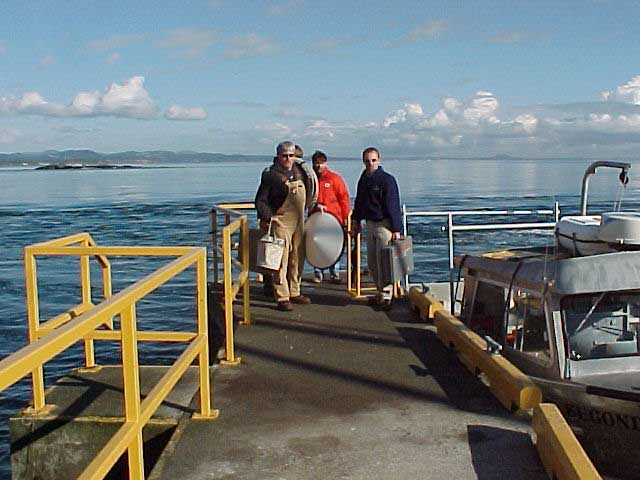
Arriving at Race Rocks with the new microwave dish
- Affixing the bracket on top of the Light tower at Race Rocks
- Bracket installation for the dish
- Installed dish viewed from above
- above the microwave dish viewed from below
- from below the microwave dish viewed from the side
- the microwave dish viewed from the side Don Nixon our electrician works with the Telus crew to solve the problem of getting the stiff cable into the tower.
- The challenge of getting inflexible radio cable from the dish outside to the radio inside without compromising the heritage structure was creatively solved.
- By using an existing tower vent to enter the lantern room.
- The hole through the edge of the hatch to the lantern room.
- The radio and switch fit neatly in under the stair-ladder of the tower,
- completing this essential component for transmission of the signal from Race Rocks to Pedder Bay.
After looking at a diagram of the tower and examining the structure, they were able to manoeuvre relatively inflexible cable up through existing conduits and ventilation shafts. The transmitter was fixed underneath the stair-ladder, and the dish was attached to the metal cage of the lighthouse and lined up with the dish at the observatory.
Thanks to PC student Peter Seem for this writeup.
racerocks.com Project Update Feb 13, 2000
The week of February 6 through 13, 2000 has plotted more progress for the racerocks.com project.
With only 27 days remaining until the system is scheduled to go on line, daily progress is required so we will meet the project deadlines.
On Monday, Coast Guard officials granted permission for us to temporarily install a 24 inch radio antenna atop the historic Race Rocks lighthouse tower. Required for the transmission of our Race Rocks video
and data signal, the antenna will be fastened by Coast Guard technicians to the ladder structure above the main light room on the tower. We are very grateful to Coast Guard officials Fred Stepchuck and Noelani Taylor for reviewing our request so efficiently.
Wednesday morning Lyle Kosola, the radio engineer from Comlink caught the 7:00 am BC Ferry from the mainland to Vancouver Island along with Telus antenna and microwave specialists Al Mireau, Dave Farley and Rob Robinson. These top Telus staff members pulled together to make the radio link happen. While Chris Blondeau took Lyle and Dave to Race Rocks Al and Rob drove to the top of the hill near Pearson College’s observatory. As the island crew laboured up the spiral staircase in the 140 year old light tower Dave set about the tough task of hand climbing a 200 plus year old Douglas Fir tree. At the 60 foot mark Dave thankfully and somewhat breathlessly reported seeing the top two stripes of the black and white lighthouse. With a strobe light held just in front of a mirror Dave was finally seen in his tree by Chris Blondeau from atop the lighthouse. With two towering trees framing the radio path like goal posts on a ridge Lyle collected the information he would need to determine the tower height required to make all this work. The swell from Tuesday’s storm was still throwing waves at the Race Rocks jetty despite the pleasant day causing the Pearson College workboat Second Nature to plunge on her spring lines so it was decided to evacuate the island crew as quickly as possible. At the antenna location Al determined the best lay out for the tower and Lyle scouted locations for the radio equipment and wiring. A very good day filled with promise.
On Thursday Lyle completed his calculations and determined that the tower height could be reduced to 60′ provided we shot the radio right through the middle of the Douglas Fir “goalposts” on the Rocky Point ridge. Its worth a try. The shorter tower (as opposed to the 100′ considered) will have much less aesthetic impact at the college site, protect a clear sky view for the College’s telescope and, we hope, save Telus a bit of money. The antenna tower was a late addition to the Telus contribution.
Friday was a very positive day for the development of the project. Work on wiring Great Race Island for the network that system designer Ken Dunham has prescribed is 75% installed. Al Mireau from Telus reports that antenna installation will begin on Tuesday February 15. Our ever watchful professional worry specialist Aengus MacIntosh will review the critical time paths at this stage. Unlike the picture 10 days ago this looks like it can actually happen! We have a few wrinkles in our server delivery plans. We meet with Ian Scott our guardian angel at Telus to devise final plans for delivery of the signal to the internet. Ian as always has some creative solutions. We also have a good conversation with Richard Catinus our contact at Apple. We are very keen on using Apple’s remarkable QuickTime software to stream our video on the net. This will of course also commit us to Apple’s computer equipment. Garry Fletcher has lusted for Apple’s new G4 computer. We are very close to a decision. Mid afternoon we meet with John Nightingale, Director of the Vancouver Aquarium Marine Science Centre and his senior science and external relations staff. Their enthusiastic support backed by a significant financial contribution is greatly appreciated. At the end of a network planning discussion with Ken Dunham it suddenly dawns on me that we have spoken with every one of our sponsors and suppliers today and they are all doing their very best for us.
Saturday, members of the public and various interested groups joined DFO and BC Parks staff to review the status of the Race Rocks Marine Protected Area plans. Marc Pakenham the DFO coordinator has lead an exhaustive series of community consultations on the plan along with Jim Morris from BC Parks. Brian Smiley, a DFO scientist gave a compelling presentation about the ecological values of Race Rocks. There appears to be real enthusiasm for the protection of the Race Rocks area and many creative ideas of how the opportunities for public access and educational uses could be accommodated were suggested. The last public presentation on the MPA plan will be at the Olympic View Golf Club on Wednesday February 16, 2000 at 19:00 hrs.
PROCEED TO NEXT UPDATE- FEB 22/2000
Thank you for your interest.
Angus Matthews
RRAB Meeting # 3 January, 2000
Regrets: Duane Freeman — Department of National Defence
Observers: Judith Burke — South Islands Aquatic Stewardship Society
- Nancy Holman DFO Communications and Judith Burke from South Islands Aquatic Society were introduced. Judith will be assisting 2WE Associates with the public meetings.
TERMS OF REFERENCE REVIEW
- Roundtable discussion and revision of Terms of Reference.
ACTION ITEM: Marc Pakenham to circulate revised Terms of Reference.
BOUNDARIES
- Marc Pakenham described the results of various information sessions and outcomes to date including: Sports Fishing Advisory Board’s endorsement of the bathymetric model; the diving community’s support of the bathymetric model with an extension to the 50 metre depth contour. The greatest amount of support was for the angularized version (Option 2.)
- Keith Symington inquired where would 50 metre contour be on the map. Marc Pakenham indicated that he would produce another map showing the 50-metre contour line.
- Marc Pakenham discussed the option of cutting off the western fingers and extending northern boundaries of the ER.
- Keith Symington suggested that we need to discuss what is important at the end of the day (e.g. the establishment of the first MPA in Canada).
- Garry Fletcher suggested that northern point of Option 2 does not need to go further than northern boundary of the ER. Race Passage falls well below the “protection unit” and protection of that area would not provide any added value to the core area.
- Angus Matthews indicated that the major users of Race Rocks from an operational perspective are one — the sports fishing community, two — the eco-tourism community and three – the dive community. We need to focus on those that are going to be using the area. The existing problems with Option 2 are: 1) the northern point in Race Passage, and 2) western fingers are prime halibut areas.
- Sean Moore indicated that he needs to have information to hand out regarding boundaries. His experience indicates that the numbers of people that fish in area has been dropping since the inception of the ER and that many people know and recognize the existing footprint.
- Sean Moore indicated that SFAB totally supports no-take of resident species but is still looking for fishing opportunities for transient species.
- Howard Breen agreed with Angus Matthews’ remark that boundaries are a “maker or breaker” issue. What is important is getting task completed. He suggested that existing boundaries won’t reach conservation goal, but future network of MPAs will add to biomass for all users.
- Kelly Francis re-iterated that during consultation or information sessions we are referring to Race Rocks and not all future MPAs. This process may be used as a template but the outcomes may not necessarily be the same.
- Cheryl Borris felt that the College is the primary constituent at Race Rocks and not fish harvesters. The ER is the land and the seabed and the MPA is water column. There are separate goals for each, but we need to keep them joined. The issue of the MPA is whether it is going to be a no-take or not. First Nations have suggested that they would suspend harvesting for 5 years. Is SFAB willing to do that?
- Tom Sampson expressed his concern that if this process was to establish a protected area than it should be protected in its entirety. He felt that a larger area would be better because there are other areas for all fishermen to go to. He suggested that First Nations would be looking to look at this project for 4 to 5 years to see if MPAs work. He indicated that the RRAB is too concerned with excluding people out of the area and out of the process, and the focus should be on the fact that we are already out of and not recognizing the natural process.
- Keith Symington indicated that to facilitate completion of the process he would rather support going back to Option 1 with a no-take provision and that changing the ER boundaries would be viewed negatively by the conservation community.
- Garry Fletcher indicated that the 20-fathom line boundary of the ER was not based on science but on limit of scuba diving. In 1990, fisheries regulations were put in place to address impact on the ecosystem from harvesting. The RRAB has to come to terms with the fact that this area is not a scientifically defensible in terms of conservation and protection but that there is an urgency to move forward. Future MPAs may need a 20-year study to determine where to put boundaries, but until that time use existing boundaries i.e.. the Ecological Reserve.
- Jim Morris indicated that the problems lie with compliance, enforcement and education. He suggested a 5-year study plan to examine options of a larger area.
- Howard Breen suggested that we need a mechanism to ensure that users know when they are in or out of the ER/MPA. The RRAB should not be hung up on boundaries – education /enforcement is the greater issue.
- Angus Matthews suggested that the essence of problem is compliance and education and that it is very hard to inform people of fishing rules when the rules are not straightforward. He felt that it was critical to collect data as to why people are at Race Rocks and what they are doing.
- Angus Matthews suggested that with the addition of a radar system they would be able to overlay boundaries on radar screen. He also indicated that they may be able to use strobe lights to signal people when they are in or out of the boundaries
- Jenny Sparkes suggested that until the objectives of the MPA are defined it is not possible to make a decision on boundaries.
- Anita Voss inquired when would the boundary questions be decided. Kelly Francis indicated that we have to finish public consultations before boundary decision can be made.
- Cheryl Borris suggested that maybe step one is to accept the existing ER boundaries as the MPA for now and plan for an incremental approach to addressing changes.
DRAFT MANAGEMENT PLAN
- Marc Pakenham distributed a copy of an example of a provincial management plan and asked for the RRAB to review it.
- Marc Pakenham indicated that the current draft management plan does not discuss governance or fiscal/financial implications and discussed ideas of an annual report as a reporting tool.
- Jim Morris described the province’s requirement for a certain format and management plan specifically for the ER.
- Angus Matthews indicated that the governments have to work together in the development of a unified management plan. Keith Symington and Tom Sampson both agreed to this point.
- Cheryl Borris inquired if the Province had a problem going forward with a joint plan.
- Jim Morris indicated that the only problem is question of format. He indicated that he would go back to his managers to let them to know that the RRAB wants a joint plan.
- Howard Breen indicated that the one of the reason he was here is to ensure that the governments work together on this pilot.
SCIENCE MEMBERSHIP
- Marc Pakenham thanked Dr. Voss for her attendance and participation. He informed the board that Scott Wallace has been unable to participate to-date because of workload and remote location. Marc asked for suggestions for another Science representative.
- Keith Symington suggested Bill Austin from the Cowichan Marine Centre.
- Gary Fletcher suggested someone from the University of Victoria would be preferable, as they would be able to generate future interest for graduate students.
- Anita Voss suggested that Bill Cosgrove or Phil Lambert from the Royal BC Museum might be good candidate.
- Gary Fletcher suggested that Norm Healy from Royal Roads may be interested.
PRESENTATION
- Gary Fletcher gave a progress report on the www.racerocks.com project.
PUBLIC PRESENTATIONS
- Marc Pakenham discussed the DND site tour and thanked Bill Laing for hosting the event.
- Marc Pakenham informed the board of the latest information sessions including the session with dive community who expressed interested in a volunteer warden program. The dive community may develop a code of conduct for divers in the ER/MPA as well as regulations regarding speed limits. Erin Bradley suggested that it was a very useful discussion about compliance and volunteer policing of the area by the people who are using the area.
- Howard Breen inquired if there was any expression of interest from the divers about sinking a wreck in the MPA. Marc Pakenham indicated there was not.
- Angus Matthews indicated that there were opportunities for local divers to participate in research at Race Rocks that require a relatively low science background (e.g. through Reefkeepers).
- Jim Morris indicated he was enthusiastic with the meeting with local divers. He felt that divers do not want anchorage in MPA and may want to include an environmental component in their training.
- Marc Pakenham discussed the presentation to the Metchosin Regional District and indicated that they will be sending a motion of support for the project.
- Marc Pakenham discussed the upcoming public consultation sessions and the possible contracting of 2WE Consultants. The target date for these sessions is the second to third week of February.
- Angus Matthews inquired as to what sort of forum would be used to inform the public of the sessions. Marc Pakenham and Nancy Holman suggested that it would be a combination of radio, and daily and weekly newspapers. Angus Matthews suggested using a Western Community site as well as in Victoria.
- Angus Matthews suggested also advertising the information on the Internet and that the presentation could use an open house type format.
- Howard Breen inquired what would be the end date for information sessions. Angus Matthews suggested that it should coincide with last public presentation.
- After a roundtable discussion around time and location Marc Pakenham indicated that February the 12th from 0930-1530 in Victoria and the 16th in Metchosin from 1930-2130 would be planned for.
OTHER BUSINESS
- Marc Pakenham discussed the opportunity to use a video teleconference facility to communicate with New Zealand sports fishers and their experience with the establishment of MPAs. Rupert Gale suggested although that was an interesting idea he cautioned that the issues are different in New Zealand than here in terms of target species and the establishment of MPAs.
Next meeting date: Feb 23 2000 1200-1600
Location: 1st Floor Parks Board Room, 800 Johnson St. Victoria
Millenium Partners, LGS and Telus visit Race Rocks with Pearson College
Photos by Victor Rakou, PC student (Russia) —–Text by Peter Seem, PC student ( US)
On January 14th, 2000, Tom Bates, Paul Longley, and a Telus representative, along with Angus Macintosh and Scott Nichol, from LGS, came out to Pearson College. After a whirlwind tour of campus from Garry Fletcher, Biology and Marine Science teacher, and Angus Matthews, administration and finance director, the group headed out to Race Rocks along with several Pearson Students.The group’s main goal for the day was to find sites for the radio or microwave transceivers that would transmit data between the college and Race Rocks.
The transmission of data will be Telus’ contribution to the project. Paul Longley, from pre-sales technical support, and Tom Bates, with microwave engineering, were there to lend their expertise. LGS’ Aengus Macintosh was acting as project manager, and Scott Nichol was recording the work for the web page the IT firm would be helping to create.
Other options, the tops of local mountains, would require running a ground cable from the site to the college, which would be both time consuming and costly. Clearly, the best option present was to aim for a site just behind Pearson College’s observatory, which was relatively clear of trees and already connected to the internet by a high speed line.
While the group also needed to deal with finding sites and running power to all of the equipment on Race Rocks, their primary concern was the data transmission. In order to get undisturbed transmission they needed a clear line of sight between two stable sites. Any trees, foliage, or other obstructions, or small movements at either end, would break up the transmission. Indeed, even being too close to the water would generate refraction that could disturb data flow.The best solution found was to start from the highest point on Race Rocks, and aim up. From the top of the lighthouse, with the aid of a sighting scope, they took stock of the options: William Head, the closest point to the island, was deemed too low to the water to allow for a clean shot.
- LGS’s Aengus MacIntosh
- Scott Nichol climbs to the top outside.
- Angus Matthews leading the tour
- At the top of the tower
- plaque at the base of the tower
- The group leaving the tower
- return to Pearson College
Garry took the group over to the tidepool that has been constructed on the West side of the island.
Plans were to install one small camera underwater in this pool to provide a window to view the emerging life and the frequent surge action .
This tidepool was rearranged and no longer functioning after the hurricane of 2006. Fortunately the underwater camera had not been installed!
=============================================
The observatory could be seen from the top of the lighthouse through a gap in the trees. The next question that had to be dealt with was whether any of the taller trees in between would provide an obstruction, and need to be topped. The prospect of gaining permission from the DND to take the tops off of one or two old growth trees on their property was frowned on because of the delays that would undoubtedly ensue. To get an answer, the team decided to take a look at the situation from the other end. A boat ride later, things weren’t much clearer. From within the dome of the observatory, it was very difficult to catch site of Race Rocks, or more importantly, the lighthouse. Despite Garry’s excited, “I see red! ” the mood was skeptical. Stripped black and white, with a red cap, the lighthouse should have stood out, if it was visible. The difficulty catching sight of it suggested that they would either need to be higher up or that a clean shot wasn’t going to be possible.
- Trying to see RR from the observatory balcony
- The observatory
- Climbing inside to look through the observatory door
No one was willing to go ahead with any other part of the project, trying to secure donors and expensive equipment, without being sure that this most fundamental requirement could be met. It was resolved that they would try a test the next day to find out just how high an observatory side tower would need to be, if indeed it was possible at all.
On January 15th, at noon at Pearson College there happened a strange sight. A giant red helium balloon flew high over the college, dancing in the breeze on a long tether tied to a banister at the observatory. While one part of the group headed out to Race Rocks, the other sent up the helium filled balloon.The helium filled balloon. Over radio from the lighthouse, they directed the balloon to be raised higher until they could see it, unmistakably and comfortably above any surrounding trees. The length of the tether, still well within the achievable height for a tower, was proof that a clear line for transmission had been found.
- Dave with the helium filled balloon
- Dave and Garry.. goodbye!
The project is ready to move into actually constructing the tower, setting up the transmission equipment, and obtaining the cameras and sensors. They hope to have transmission established and two cameras up and running by March 11, 2000.
Race Rocks MPA Advisory Board meeting 2
RACE ROCKS ADVISORY BOARD MEETING # 2
DRAFT MINUTES
11h00 – 15h30, JANUARY 5, 2000
LESTER B. PEARSON COLLEGE, VICTORIA
Participants: Howard Breen – Georgia Strait Alliance
Regrets:Doug Biffard – BC Parks
Observers:Sean MacConnachie – Fisheries and Oceans Canada
***************************************
INTRODUCTIONS
- The meeting began with a roundtable introduction of the participants.
TERMS OF REFERENCE DISCUSSION (TOR)
- Marc Pakenham read the draft Terms of Reference and indicated that it is a rough draft and still requires the input from the RRAB and TOR sub-committee. Comments from Jenny Sparkes and Gord Hansen have been received. Jenny Sparkes wasn’t clear what the RRAB outcomes were supposed to be from the TOR and has suggestions for each point.
- Angus Matthews suggests that the TOR are quite adequate and don’t need revision. He is keen to move on with rest of process.
- Jenny Sparkes indicated that it is important in this process that people are clear of the game rules from the outset.
- Howard Breen agreed that the TOR is good and need to move forward with this process.
- Roundtable review of the TOR.
- Anita Voss inquired if there was a time frame for the goals set out in the TOR. Marc Pakenham replied that the goal was to have the recommendations completed by March 10. Kelly Francis indicated that the future evolution of the RRAB was not entirely clear.
- Angus Matthews re-iterated the importance of moving forward with this process. Pearson College is currently funding the caretaker and bearing responsibility for the operating costs at Race Rocks. They are unable to raise further funds until this site is designated. He suggested that governments have to understand that private funds are driving this process.
- Howard Breen suggested that in regards to the First Nations paragraph it is important to identify which First Nations are being affected by this process (i.e. T’souke, Esquimalt, Beecher Bay, and Songhees First Nations).
- Tom Sampson indicated that it is important to have First Nations mentioned in this process being that it may be a template for future processes. He suggested that First Nations do not need to be identified directly because the First Nations will know which ones are directly involved.
- Jim Morris would like to see it spelled out in the TOR that Race Rocks is an Ecological Reserve and that the establishment of a MPA will enhance and/ or preserve the current status.
- Angus Matthews believes consensus is where everybody is reasonably content and walks away from the table satisfied. Being that this is a pilot process the consensus “bar” should be set higher than is stated in the draft TOR. Marc Pakenham suggested that recommendations will probably not please everyone 100%, but this process will respect and provide the opportunity to indicate their views.
- Howard Breen suggested that if the RRAB could endorse the recommendations 100% they would be accepted much more broadly throughout the community.
- Keith Symmington asked to have these comments read into the minutes: “CPAWS supports the establishment of a ‘protocol agreement’ between the Province and Fisheries and Oceans Canada, as well as the recognition of the Constitutional and treaty rights of First Nations and their interest in a cooperative management regime, within the Terms of Reference“.
- Marc Pakenham asked the RRAB members to send comments to him by Friday January 7, 2000. He will synthesize the comments and have a conference call on Tuesday Jan 11 with the TOR sub-committee and will have a revision out to RRAB board members by Tuesday afternoon.
ECOSYSTEM OVERVIEW PRESENTATION
- Brian Smiley introduced himself and the purpose of the presentation including:
- The background of ecosystem overview;
- the MS Access database created by the College; and
- Cindy Wright’s contract to synthesize the ecosystem overview into a written report format which outlines major gaps in our current knowledge and provides general recommendations on future research. The report does not address socio-economic information, nor does it provide strategies or actions for implementing research recommendations.
- Cindy Wright described the report and it was based on a similar report prepared for Sable Gully. It is oriented for aquatic issues.
- Outstanding physical features at Race Rocks:
- High velocity currents up to 6 knots. High velocity currents create turbulence which mixes water column, prevents stratification, delivers high nutrients, and high oxygen content to support benthic community;
- High nutrients and rocky substrate attract lots of animals and high larval recruitment;
- Algal biomass: 110ha X 67 metric tonnes/ ha = 7370 metric tonnes of algae/year;
- 130 known species/genera of phytoplankton and 100 zooplankton;
- Over 200 species/genera of invertebrates. High abundance and high diversity including a strong population of threatened abalone;
- Critical habitat for species of rockfish, lingcod, and kelp greenling. Not knowledgeable of fish distribution through lifecycle. About 95 known species of near-shore fish;
- Marine mammals: Haul-out site/ rafting for pinnipeds. Predominantly used by harbour seals for all lifestages. 2nd largest seal haul-out in Canadian waters of Georgia Basin. At times can represent 20% of seal population in area. Reports of up to 1000 seals reported at Race Rocks. Reported as a high use area for transient Orca;
- Birds: 4-5 species use Race Rocks as a nesting site. 23% of pelagic cormorants in eastern Juan de Fuca are at Race Rocks; and
- Traditional Ecological knowledge. Pearson college working with First Nations and fisherman to acquire knowledge.
- Marc Pakenham asked if we could have this presentation to circulate. Brian Smiley indicated that he would make it available, but that it is a high-grade of the draft report. Hopes to keep this document and databases as a living document to be updated in future.
- Howard Breen inquired if the Ecosystem Overview supported an extension of the boundaries of the ecological reserve. Brian Smiley suggested that we now have a baseline to go from; therefore depending on which objective is focused upon will determine the requirements of the boundaries (e.g. If the objective is to protect a nesting area, the boundaries are probably sufficient. If the objective is to protect foraging sights the boundaries may be too small).
- Garry Fletcher suggested that the existing boundary would work very well if everybody abided by it. He expressed concerns that the annual changes of animal’s behaviour may put them outside the boundaries. He indicated that he would hate at this stage for boundary discussions to prevent decisions being made. He suggested that flexibility needs to be maintained as information is acquired.
LUNCH
BOUNDARY DISCUSSION
- Marc Pakenham reviewed the boundary options that have been presented to stakeholders. He described enforcement problems with existing boundaries in regards to depth in meters. Feedback to date supports mostly option 2, the angularized boundaries of the ER. This option does not reduce the size of the ecological reserve, but does make it easier to describe by legal terms and is easier for mariners. The boundaries could possibly use buoys or sight markers. Option 2 is approximately 10% larger than existing ER boundaries. Option three has a 100 metre buffer zone around angularized option 2.
- Howard Breen suggested that the Georgia Strait Alliance generally support the concept of buffer zones. With this particular case it may be feasible to increase seabed protection, but not reduce pelagic fishing opportunities outside existing boundaries.
- Brian Smiley inquired if it was possible to extend the boundary along the bottom to protect the important habitat that some threatened species use during part of the year.
- Sean Moore indicated that the SFAB fully endorses the protection of rockfish within the existing area, but is looking for the continuation of fishing opportunities for transient species (e.g. halibut and salmon) within the existing reserve.
- Angus Matthews reminded the group that the objective for a MPA in general is not only to protect species and habitat but to increase research and public education. Overlaying existing boundaries of MPA with ER would be easier politically. Problems with the option 2 lie on south west corner of ecological reserve where there are two halibut fishing spots. Angus Matthews suggested that the SFAB might agree to a no-take in the existing area if the boundaries did not increase. Other issues to take into consideration include flying tourism. He suggests that a small footprint would be a more effective to designate and further rockfish closures are a separate fisheries issues.
- Jim Morris indicated that this MPA cannot solve all problems today. The management plan could make a recommendation for a future increase in the size of the MPA or possibly a creation of another ER or increase in the size of the ER.
- Tom Sampson indicated that we should be aware that there are existing Supreme Court decisions that grant First Nations absolute rights to the fishery resources as well as treaty rights that supersede any new rules. It is important to recognize that if you only protect / manage the shoreline you’re ignoring the natural spawning process and interaction between the shallow and deepwater. Nature has provided existing patterns that we are ignoring, the pattern or options that we are promoting do not comply to these existing patterns.
- Anton Roberts inquired if this area is going to be an absolute “no-go zone”. Kelly Francis described minimum levels of protection under Pacific MPA strategy and that this process will define the levels of protection for Race Rocks. It is anticipated that Race Rocks MPA marine components will continue to offer public access under some guidelines or regulatory authority.
- Howard Breen indicated that although the Georgia Strait Alliance supports a larger area, they would not block consensus if the RRAB recommends maintaining the existing boundaries with an angularized version. Their larger concern is that the energy and resources that have gone into the pilots will not be carried on to future candidates.
- Marc Pakenham indicated that enforcement is a major issue. He felt that stakeholders would support a relatively small MPAs if they were properly enforced.
- Cindy Wright asked what level of protection the buffer zone would offer. Marc Pakenham responded that the buffer zone would offer a different level of protection.
- Rupert Gale suggested that the angularized areas of option 2 could be the buffer zone.
- Angus Matthews suggested that angularized version isn’t critical for habitat. For managing the area radar would be effective in managing boaters that enter into the area.
- Anita Voss suggested that invertebrates contribute significant amounts of biomass via their larvae into the environment.
- Jim Morris suggested that the important part of this process is to inform the people of what they can and cannot do in the area. Suggests that during the ER consultation consensus was essentially reached, and changes in the area would not be effective.
- Garry Fletcher felt that there were large safety concerns with using anchors and buoys in the area.
- Brian Smiley indicated that any MPA will have to be Gazetted and described legally. Therefore a bathymetric definition of the area would not be an effective method to enforce. He suggests that using a GPS enforceable definition would be a lot more effective in monitoring and compliance.
- Howard Breen suggested that the bathymetry for this area may be the best defined for the whole coast, but as a precedent, it is not an effective system because future MPAs will not be have this level of bathymetric observation.
- Tom Sampson suggests that the MPA could be in place for a certain amount of time and then re-evaluated. He described the process of restoration of Goldstream river and the resolution of the fisheries conflict between First Nations and the commercial fishery. By having everyone agree to stop fishing over four years (one life cycle) 60, 000 salmon returned, up from 4,000. After 8 years (2 cycles) there were over 100, 000 fish returning to spawn. Today a sustainable harvest of 60, 000 Chum adults are taken annually.
- Angus Matthews suggests that the boundaries need to be better defined.
- Jenny Sparkes suggested that these MPAs will not manage the resource but peoples’ activities. In other parts of the world straight lines have been shown to be more effective and easier to understand.
- Sean Moore requires a better-defined map with bathymetric lines and boundaries by Jan 20, 2000 for his presentation to the SFAB.
ACTION ITEM
Marc Pakenham to provide an image of Race Rocks with existing ecological boundaries in relation to navigational bathymetric contour lines.
- Keith Symmington asked to have these comments read into the minutes: “CPAWS believes that a “angularized” or even “rectangular” scenario would be the most logical boundary, for practicality reasons previously discussed at the inaugural meeting.“
MPA / ER MANAGEMENT PLAN DISCUSSION
- Marc Pakenham described the evolution of current Race Rocks ER/MPA management plan draft.
- Marc Pakenham asked the group to review the draft management plan and comment within the next two weeks.
- Cheryl Borris inquired who had prepared this plan. Marc Pakenham responded that he had taken former drafts and modified them to be in line with the format of the Pacific MPA Strategy Discussion Paper.
- Angus Matthews indicated that he has been urging Marc Pakenham and Kelly Francis to get this document out for discussion and review. He indicated that it is not a pre-defined, pre-determined idea from Fisheries and Oceans Canada. The College originally wrote this document for the ecological reserve. He hopes that it ends up as a document that government can use.
- Kelly Francis re-iterated the importance to have input from the RRAB to determine what is missing and to contribute to the management plan.
Marc Pakenham suggested a number of key issues that were missing include: 1) governance—who will manage the ER/MPA. 2) Finances –how do we pay for this? 3) Developing a list of priority issues and strategies.
ACTION ITEM
Marc Pakenham to send this draft electronically to the RRAB members.
- Jim Morris suggested that previous consultation indicated that the water column and management of the fisheries are probably the utmost concern.
- Jenny Sparkes suggests posting the socio-economic and scientific reports on the Internet so that people can access them when they review the management plan.
ACTION ITEM
Garry Fletcher to post reports on the Race Rocks Internet site and distribute address.
- After briefly reviewing the draft ER/MPA Draft Management plan Bill Laing indicated that DND does not have a weapons test site. They have two explosive disposal sites and one training site.
- Angus Matthews indicated that the information regarding First Nations is outdated and needs to be changed.
- Jenny Sparkes suggested changing the name to Interim Management Recommendations from draft management plan. Fisheries and Oceans Canada/BC Parks will be responsible for final management plan.
- Keith Symmington asked to have these comments read into the minutes: “CPAWS believes that the new round of MPA consultations should be with a view to advance the designation of a full no-take MPA at Race Rocks (without prejudice to Constitutional and treaty rights of First Nations). We believe that the closures on groundfish and shellfish in the existing ER are not insufficient in realizing one of the main conservation objectives for the site, namely the restoration of commercial groundfish species, particularly rockfish and lingcod. By allowing salmon and halibut sportfishing to continue (given the documented bycatch of these species in non-targeted scenarios, and the low expectation for survival once caught), this particular (and essential) MPA management goal will not be realized. Judging from consultations initiated to date, and direct feedback from stakeholders, there is considerable support for such a designation.
CONSULTATIONS AND INFORMATION SESSIONS
- Marc Pakenham has given presentations to the following groups:
- December 61999 with Sea to Sea Blue/Green Belt Conservancy, Rural East Sooke Assoc., Society for the Protection of Ayum Creek, Saanich Inlet Protection Society and Land Conservancy Trust
- December 9, 1999 Department of National Defence
- December 13 presentation to the CRD Roundtable on the Environment..
- December 14, 1999 BC Parks, LUCO and Ministry of Fisheries
- December 14, 1999 Sports Fishery Advisory Board ,another to follow soon.
- December 22, 13 moons First Nations’ presentation to the RRAB.
- Marc Pakenham is scheduling presentations with Tourism Victoria, Royal Roads University, University of Victoria, Royal BC Museum, Rotary Club Victoria and District of Metchosin in the next few weeks.
- If RRAB members’ constituents are interested in a presentation please inform Marc Pakenham.
- Kelly Francis hoping to schedule two large public meetings/consultations near the end of January.
- Tom Sampson indicated that he has been talking with local tribes and suggests that they all are interested in the process but don’t want to be involved in if it interferes with Treaty process. They would like to meet separately.
ACTION ITEM
- Marc Pakenham to send information package to Tom Sampson for local area First Nations.
OTHER BUSINESS
- Bill Laing discussed the idea of a tour at DND facilities and will pass out information to Marc Pakenham when he has a determined time.
- Angus Matthews talked about the “racerocks.com” project information session at Telus tomorrow and invited those in attendance if they wished to come.
Next proposed meeting date:
26 January, 2000 – 12h00 to 16h00
at Pearson College (lunch will be provided @ 12h00)
STAKEHOLDER GROUPS to be consulted Fos MPA Advisory Board
WHO WILL BE CONSULTED??
The following list is subject to revision but identifies most stakeholder groups at this time (06.12.99).
Amalgamated Conservation Society
Aquarius Dive Club — DND
BC Shorekeepers/Reefkeepers Assoc.
BC MELP
BC MOF
Canadian Coast Guard – DFO
Canadian Wildlife Service
Capital Regional District – Roundtable on the Environment,- Environment Committee
Department of National Defence – CFB Esquimalt
District of Metchosin
Environmental Risk Management – CFB Esquimalt
Environmental Youth Alliance
First Nations – Beecher Bay, Esquimalt, Songhees, T’sartlip, T’souke
Frank White’s Scuba Shop
Friends of Ecological Reserves
Georgia Strait Alliance
Greater Victoria Natural History Society
Green/Blue Belt Conservancy Society
Habitat Acquisition Trust
Juan de Fuca Economic Development Commission
Lester B. Pearson College
Local marinas
Ogden Point Dive Centre
Ocean Centre
Parks Canada PMHL
Pedder Bay Marina
Royal BC Museum
Saanich Inlet Protection Committee
Sierra Club of British Columbia
Society for the Protection of Ayum Creek
South Island Aquatic Stewardship Society
Sports Fish Advisory Board – Race Rocks Sub-Committee
Tourism Victoria – Environment Committee
University of Victoria
Veins of Life Watershed Society
Victoria Golden Rods and Reels
Victoria Natural History Society
Victoria Marine Adventure Centre
Victoria Marine Advisory Council
Whale Watch Operators Association NW?
World Fisheries Trust
| Return to RRAB Index |
 |
 |
Sitemap | Contact |
webmaster:
Garry Fletcher |
Copyright |
Community Involvement in Marine Protected Areas- Pearson College Communications with Federal Government Levels 1994-1999
.
Matthews-Angus 1999 Community Involvement in Marine Protected Areas- Pearson College Communications with Federal Government Levels 1994-1999 . . . . ————- . 577.7 Com I
This series of documents presents the efforts of Angus Matthews, administrator of Lester B. Pearson College, to offer to the federal government a model of Community participation in creating a marine education center at Race Rocks. It begins with initiation of the proposal in order to provide for a continued presence of personnel at the Race Rocks Ecological Reserve, when the destaffing of the light station is looming on the horizon. The communications between Mr. Matthews and officials of the Canadian Coast Guard, and with the office of the Minister of Fisheries are represented in chronological order. This is the second of two records of communications, document #26 representing the Communications at the Provincial Parks Level. that were going on simultaneously. This series of documents presents an excellent chronological account of the frustrated efforts of an organization in the community to facilitate a constructive solution to the destaffing of light stations and the simultaneous provision of on sight protection for a sensitive ecological area.
.
Matthews-Angus 1999 Community Involvement in Marine Protected Areas- Pearson College Communications with Provincial Government 1994-1999 with Provincial Levels of government . .. … . ————— . 577.7.Com This series of documents presents the efforts of Angus Matthews, administrator of Lester B. Pearson College, to offer to the federal government a model of Community participation in creating a marine education center at Race Rocks. It begins with initiation of the proposal in order to provide for a continued presence of personnel at the Race Rocks Ecological Reserve, when the destaffing of the light station is looming on the horizon. The communications between Mr. Matthews and officials of the Provincial Parks Department are represented in chronological order. This is the second of two records of communications, (document #25 representing the Communications at the Federal Fisheries and Oceans Department,) that were going on simultaneously during a 5 year period. 1994-1999. Government of British Columbia This series of documents presents an excellent chronological account of the often frustrating efforts of an organization in the community to facilitate a constructive solution to the destaffing of light stations and the simultaneous provision of on-site protection for a sensitive ecological area. .
June 20, 1994 Pearson College writes to The Hon. Moe Sihota, Minister of the Environment and Esquimalt – Metchosin MLA to request support for BC Parks involvement in an initiative to operate surplus facilities at Race Rocks as a marine education Centre.
June 29, 1994 Minister Sihota writes and expresses interest in the project.
Dec. 21, 1995 The Hon. Glen Clark, Minister of Employment and Investment writes to Federal Fisheries Minister Brian Tobin and request a delay in de-staffing light stations.
July 8, 1996 Newly appointed Environment Minister The Hon. Paul Ramsey writes to express interest in the plans for Race Rocks and to advise that a management plan is required before his Ministry can proceed. He expects the plan to take one year to be written.
July 25, 1996 Pearson College proposes fast tracking the management plan.
Sept. 20, 1996 The Ministry of Employment and Investment commissions a report to look into the potential of commercial uses for Race Rocks.
Oct. 11, 1996 Minister Ramsey writes to advise that the Province is considering a coast wide plan to operate light stations. Any decision on Race Rocks would wait for this review.
Oct. 29, 1996 Pearson College writes to BC Parks, District Manager, Mr. Dave Chater regarding the imminent closure of Race Rocks station, the need for rapid progress on the management plan and advises that the College will pursue Federal Marine Protected Area status for the Reserve.
Oct. 31, 1996 Mr. Denis O’Gorman, Assistant Deputy Minister of Parks writes to Mr. Rick Bryant, at Coast Guard, to advise that BC Parks did not have a use for surplus buildings at Race Rocks under the current management plan. A new plan would review this and it would be finished in early 1977.
Jan. 30, 1997 Newly appointed Minister of the Environment The Hon. Cathy McGregor writes to confirm the target date for completion of the management plan as early 1997.
Feb. 12, 1997 Assistant Deputy Minister O’Gorman writes to advise that BC Parks would support Pearson College’s application for a Crown lease on Race Rocks.
Mar. 1, 1997Pearson College takes over staffing Race Rocks under a temporary two year agreement with the Coast Guard.
April 11, 1997 Pearson College applies to BC Lands for a 30 year Crown lease for Race Rocks.
Dec. 19, 1997 Mr. Dave Chater writes that BC Parks is prepared to enter into an agreement in principle with Coast Guard. The draft management plan, which is still incomplete, is being amended.
April 14, 1998 Mr. Chris Kissinger, Resource Officer at BC Parks writes to Mr. Fred Stepchuk, Superintendent of Facilities, Coast Guard, to summarize repairs required to surplus facilities at Race Rocks prior to transfer to BC Parks.
Sept. 1, 1998 Minister Anderson announces Race Rocks will be a pilot Marine Protected Area.
Dec. 15, 1998 Mr. Dave Chater writes to Mr. Fred Stepchuk at Coast Guard regarding transfer of the surplus facilities.
Mar. 1, 1999 Pearson College staff remain at Race Rocks although BC Parks has not reached an agreement with Coast Guard regarding the transfer of facilities. The management plan is still not finished.
